ADACC – Chapter 11
VerifiedAdded on 2023/01/13
|26
|5885
|88
AI Summary
This document contains answers to short answer questions on various topics including scarcity and opportunity cost, economic systems, the global financial crisis, Australian government actions, capital adequacy ratios, exchange rate determination, and the current account deficit in Australia.
Contribute Materials
Your contribution can guide someone’s learning journey. Share your
documents today.
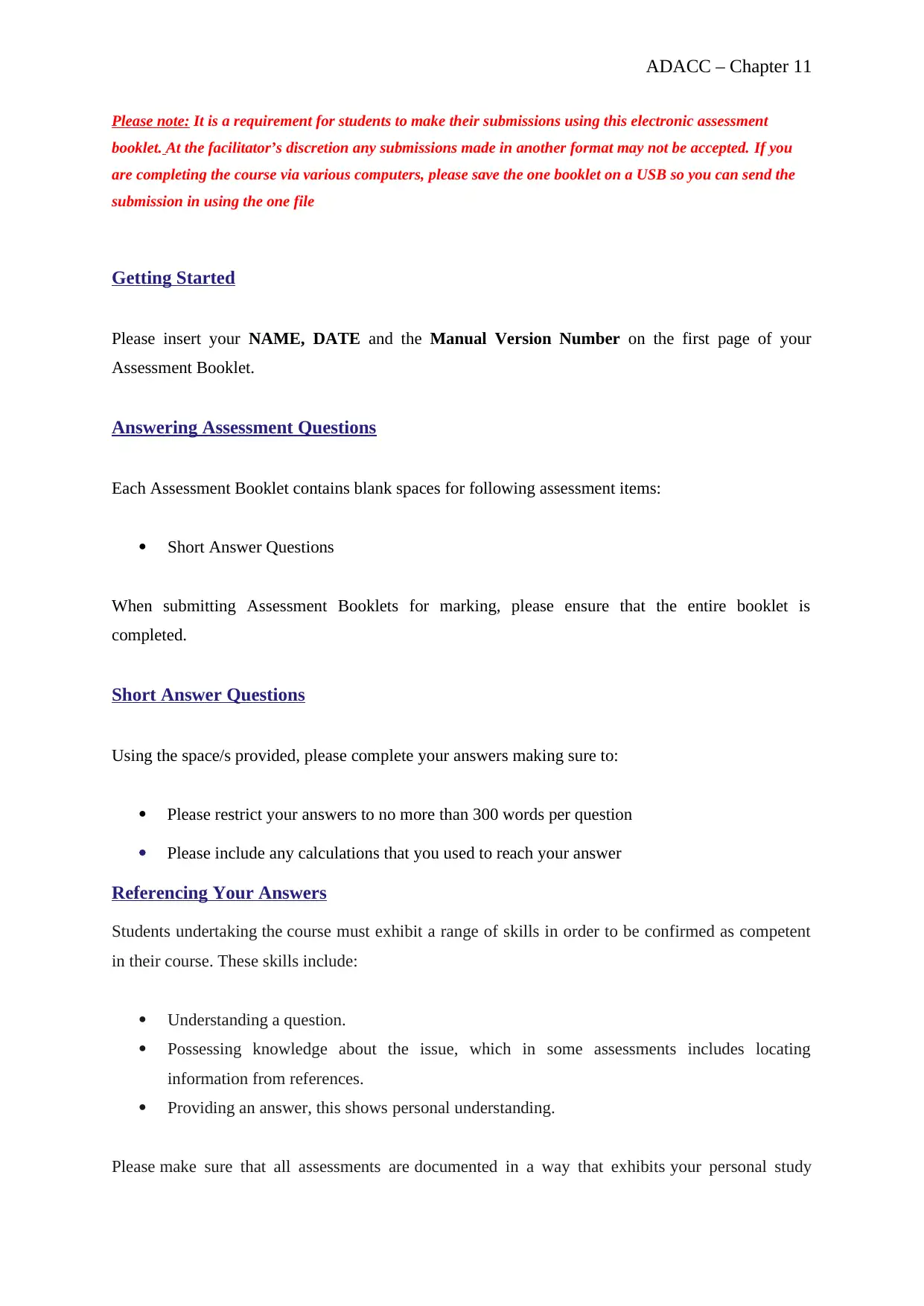
ADACC – Chapter 11
Please note: It is a requirement for students to make their submissions using this electronic assessment
booklet. At the facilitator’s discretion any submissions made in another format may not be accepted. If you
are completing the course via various computers, please save the one booklet on a USB so you can send the
submission in using the one file
Getting Started
Please insert your NAME, DATE and the Manual Version Number on the first page of your
Assessment Booklet.
Answering Assessment Questions
Each Assessment Booklet contains blank spaces for following assessment items:
Short Answer Questions
When submitting Assessment Booklets for marking, please ensure that the entire booklet is
completed.
Short Answer Questions
Using the space/s provided, please complete your answers making sure to:
Please restrict your answers to no more than 300 words per question
Please include any calculations that you used to reach your answer
Referencing Your Answers
Students undertaking the course must exhibit a range of skills in order to be confirmed as competent
in their course. These skills include:
Understanding a question.
Possessing knowledge about the issue, which in some assessments includes locating
information from references.
Providing an answer, this shows personal understanding.
Please make sure that all assessments are documented in a way that exhibits your personal study
Please note: It is a requirement for students to make their submissions using this electronic assessment
booklet. At the facilitator’s discretion any submissions made in another format may not be accepted. If you
are completing the course via various computers, please save the one booklet on a USB so you can send the
submission in using the one file
Getting Started
Please insert your NAME, DATE and the Manual Version Number on the first page of your
Assessment Booklet.
Answering Assessment Questions
Each Assessment Booklet contains blank spaces for following assessment items:
Short Answer Questions
When submitting Assessment Booklets for marking, please ensure that the entire booklet is
completed.
Short Answer Questions
Using the space/s provided, please complete your answers making sure to:
Please restrict your answers to no more than 300 words per question
Please include any calculations that you used to reach your answer
Referencing Your Answers
Students undertaking the course must exhibit a range of skills in order to be confirmed as competent
in their course. These skills include:
Understanding a question.
Possessing knowledge about the issue, which in some assessments includes locating
information from references.
Providing an answer, this shows personal understanding.
Please make sure that all assessments are documented in a way that exhibits your personal study
Secure Best Marks with AI Grader
Need help grading? Try our AI Grader for instant feedback on your assignments.
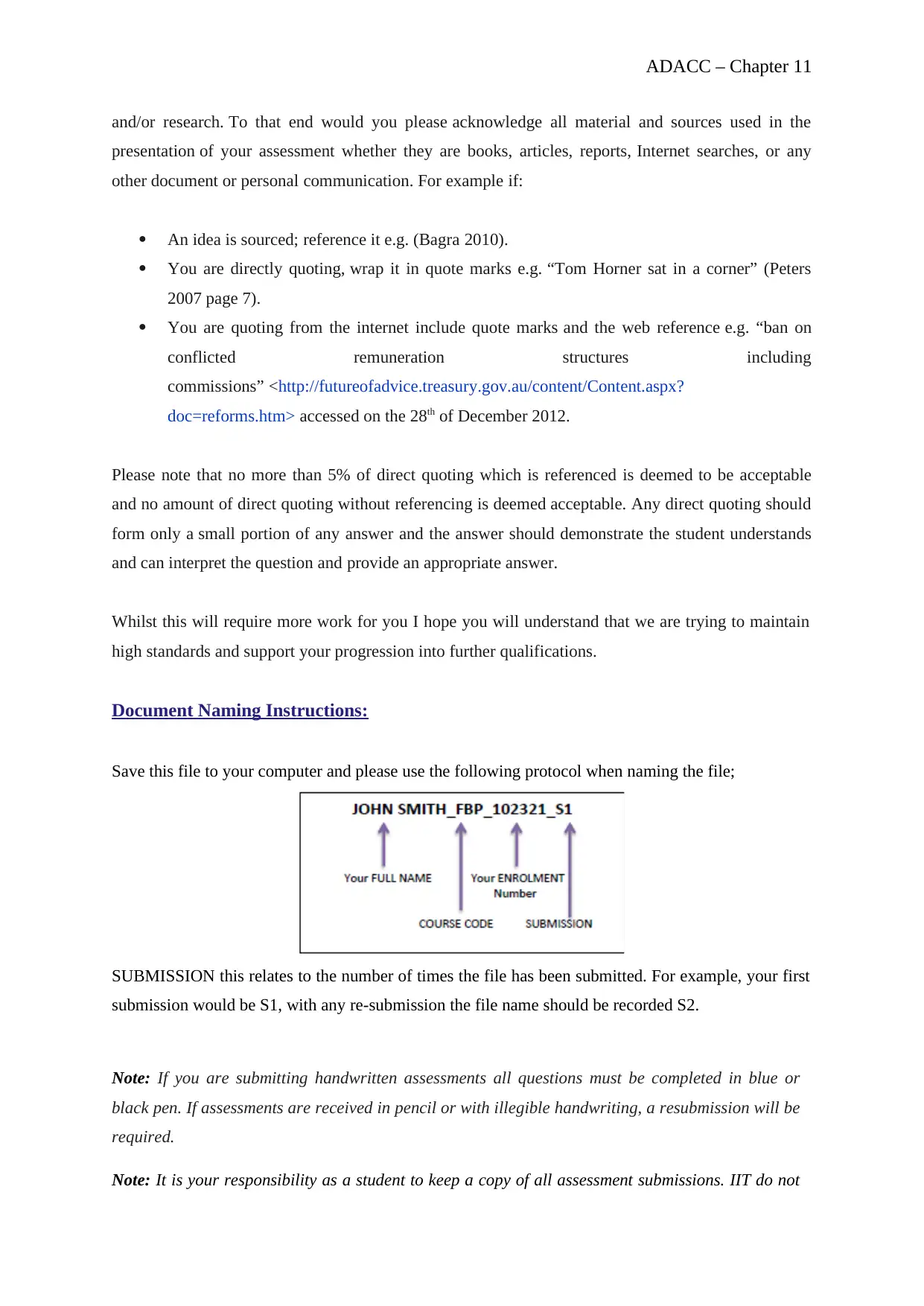
ADACC – Chapter 11
and/or research. To that end would you please acknowledge all material and sources used in the
presentation of your assessment whether they are books, articles, reports, Internet searches, or any
other document or personal communication. For example if:
An idea is sourced; reference it e.g. (Bagra 2010).
You are directly quoting, wrap it in quote marks e.g. “Tom Horner sat in a corner” (Peters
2007 page 7).
You are quoting from the internet include quote marks and the web reference e.g. “ban on
conflicted remuneration structures including
commissions” <http://futureofadvice.treasury.gov.au/content/Content.aspx?
doc=reforms.htm> accessed on the 28th of December 2012.
Please note that no more than 5% of direct quoting which is referenced is deemed to be acceptable
and no amount of direct quoting without referencing is deemed acceptable. Any direct quoting should
form only a small portion of any answer and the answer should demonstrate the student understands
and can interpret the question and provide an appropriate answer.
Whilst this will require more work for you I hope you will understand that we are trying to maintain
high standards and support your progression into further qualifications.
Document Naming Instructions:
Save this file to your computer and please use the following protocol when naming the file;
SUBMISSION this relates to the number of times the file has been submitted. For example, your first
submission would be S1, with any re-submission the file name should be recorded S2.
Note: If you are submitting handwritten assessments all questions must be completed in blue or
black pen. If assessments are received in pencil or with illegible handwriting, a resubmission will be
required.
Note: It is your responsibility as a student to keep a copy of all assessment submissions. IIT do not
and/or research. To that end would you please acknowledge all material and sources used in the
presentation of your assessment whether they are books, articles, reports, Internet searches, or any
other document or personal communication. For example if:
An idea is sourced; reference it e.g. (Bagra 2010).
You are directly quoting, wrap it in quote marks e.g. “Tom Horner sat in a corner” (Peters
2007 page 7).
You are quoting from the internet include quote marks and the web reference e.g. “ban on
conflicted remuneration structures including
commissions” <http://futureofadvice.treasury.gov.au/content/Content.aspx?
doc=reforms.htm> accessed on the 28th of December 2012.
Please note that no more than 5% of direct quoting which is referenced is deemed to be acceptable
and no amount of direct quoting without referencing is deemed acceptable. Any direct quoting should
form only a small portion of any answer and the answer should demonstrate the student understands
and can interpret the question and provide an appropriate answer.
Whilst this will require more work for you I hope you will understand that we are trying to maintain
high standards and support your progression into further qualifications.
Document Naming Instructions:
Save this file to your computer and please use the following protocol when naming the file;
SUBMISSION this relates to the number of times the file has been submitted. For example, your first
submission would be S1, with any re-submission the file name should be recorded S2.
Note: If you are submitting handwritten assessments all questions must be completed in blue or
black pen. If assessments are received in pencil or with illegible handwriting, a resubmission will be
required.
Note: It is your responsibility as a student to keep a copy of all assessment submissions. IIT do not

ADACC – Chapter 11
take responsibility for the loss of any submissions.
Distance Education Students
take responsibility for the loss of any submissions.
Distance Education Students

ADACC – Chapter 11
Student Declaration
I understand that by completing this form I am bound by the following
declaration.
To the best of my knowledge and belief, no part of this assignment for the
above unit has been copied from any other student’s work or from any other
source except where due acknowledgment is made in the text, or has been
written for me by another person.
Name: Date:
Student Declaration
I understand that by completing this form I am bound by the following
declaration.
To the best of my knowledge and belief, no part of this assignment for the
above unit has been copied from any other student’s work or from any other
source except where due acknowledgment is made in the text, or has been
written for me by another person.
Name: Date:
Secure Best Marks with AI Grader
Need help grading? Try our AI Grader for instant feedback on your assignments.
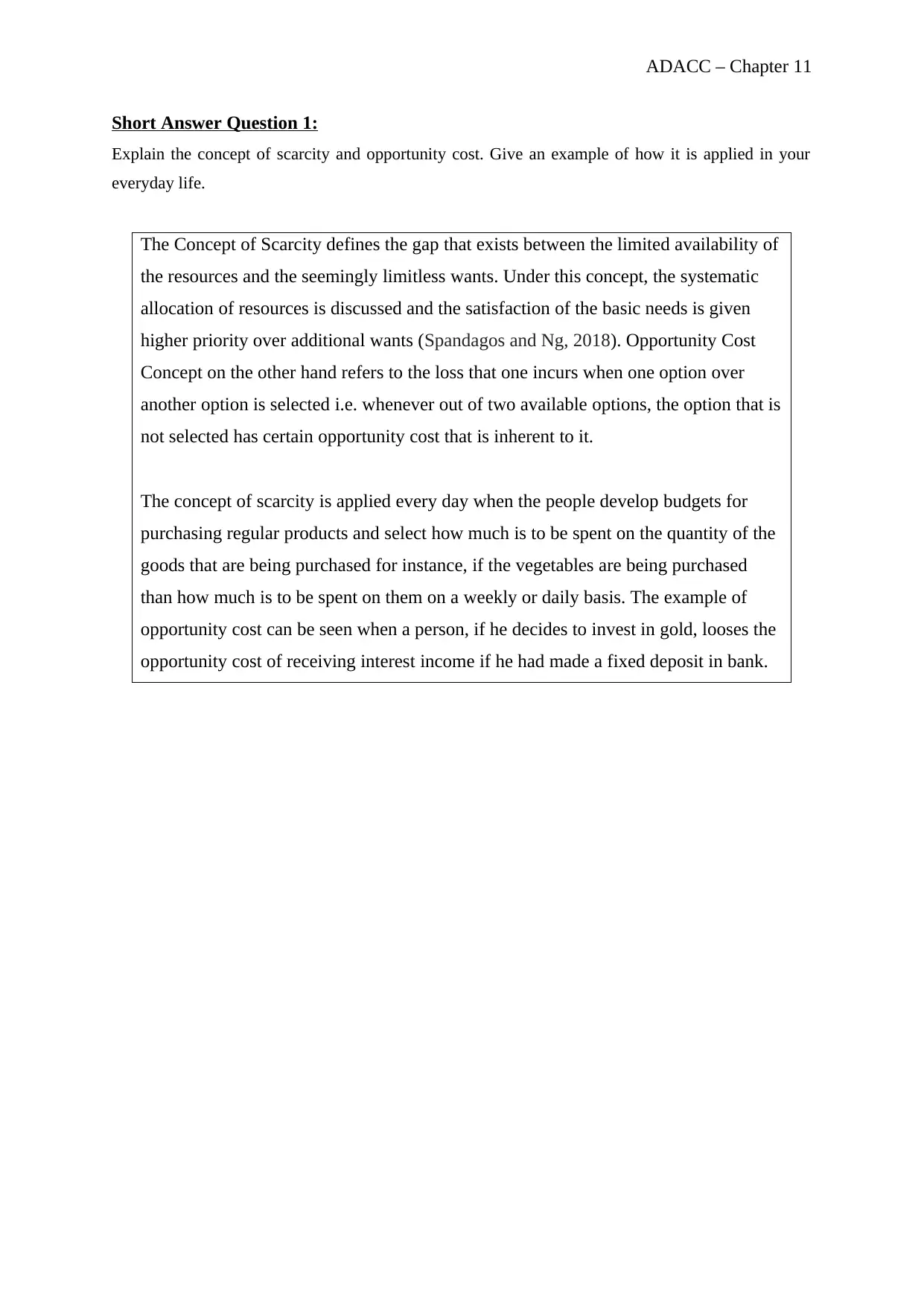
ADACC – Chapter 11
Short Answer Question 1:
Explain the concept of scarcity and opportunity cost. Give an example of how it is applied in your
everyday life.
The Concept of Scarcity defines the gap that exists between the limited availability of
the resources and the seemingly limitless wants. Under this concept, the systematic
allocation of resources is discussed and the satisfaction of the basic needs is given
higher priority over additional wants (Spandagos and Ng, 2018). Opportunity Cost
Concept on the other hand refers to the loss that one incurs when one option over
another option is selected i.e. whenever out of two available options, the option that is
not selected has certain opportunity cost that is inherent to it.
The concept of scarcity is applied every day when the people develop budgets for
purchasing regular products and select how much is to be spent on the quantity of the
goods that are being purchased for instance, if the vegetables are being purchased
than how much is to be spent on them on a weekly or daily basis. The example of
opportunity cost can be seen when a person, if he decides to invest in gold, looses the
opportunity cost of receiving interest income if he had made a fixed deposit in bank.
Short Answer Question 1:
Explain the concept of scarcity and opportunity cost. Give an example of how it is applied in your
everyday life.
The Concept of Scarcity defines the gap that exists between the limited availability of
the resources and the seemingly limitless wants. Under this concept, the systematic
allocation of resources is discussed and the satisfaction of the basic needs is given
higher priority over additional wants (Spandagos and Ng, 2018). Opportunity Cost
Concept on the other hand refers to the loss that one incurs when one option over
another option is selected i.e. whenever out of two available options, the option that is
not selected has certain opportunity cost that is inherent to it.
The concept of scarcity is applied every day when the people develop budgets for
purchasing regular products and select how much is to be spent on the quantity of the
goods that are being purchased for instance, if the vegetables are being purchased
than how much is to be spent on them on a weekly or daily basis. The example of
opportunity cost can be seen when a person, if he decides to invest in gold, looses the
opportunity cost of receiving interest income if he had made a fixed deposit in bank.
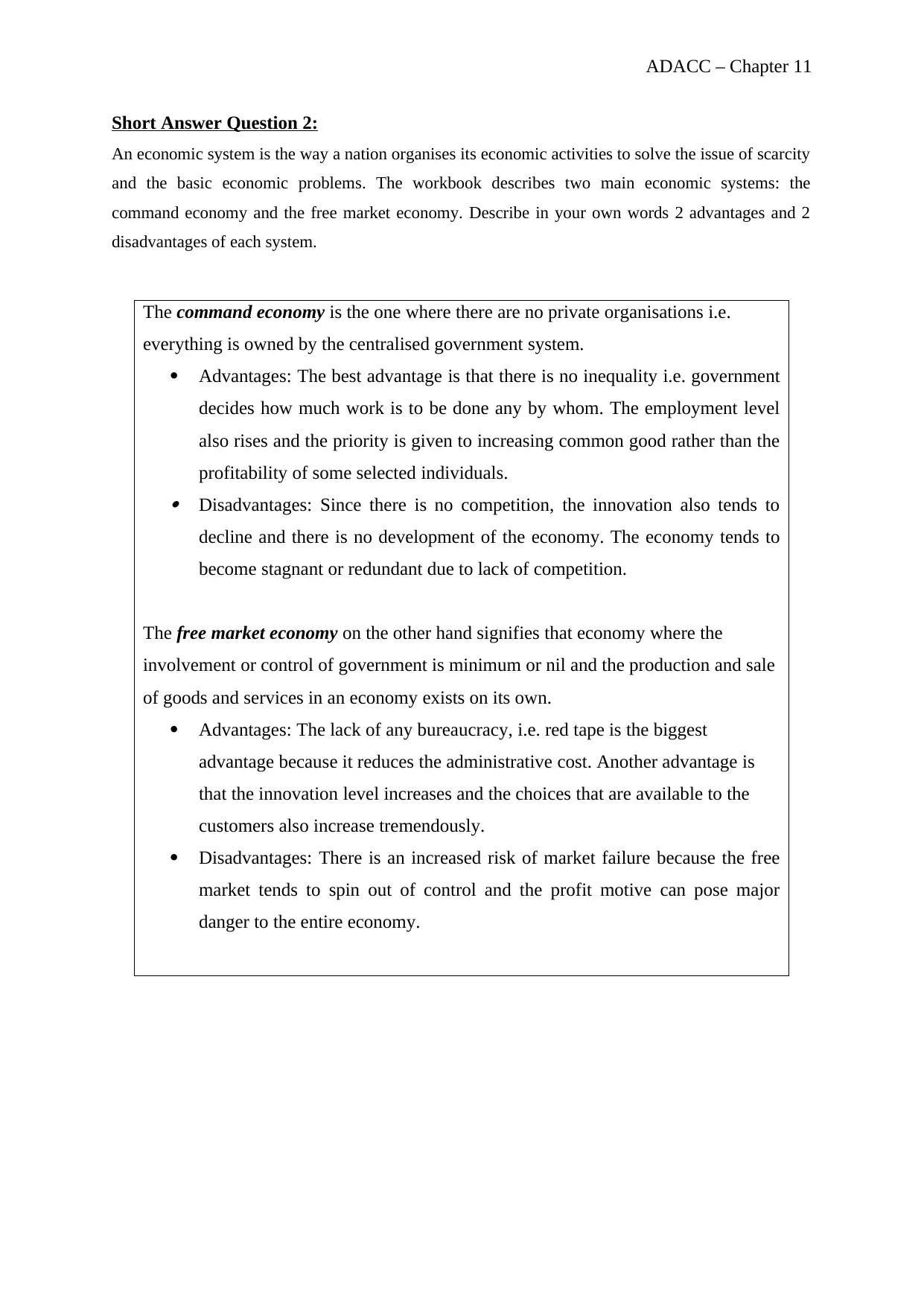
ADACC – Chapter 11
Short Answer Question 2:
An economic system is the way a nation organises its economic activities to solve the issue of scarcity
and the basic economic problems. The workbook describes two main economic systems: the
command economy and the free market economy. Describe in your own words 2 advantages and 2
disadvantages of each system.
The command economy is the one where there are no private organisations i.e.
everything is owned by the centralised government system.
Advantages: The best advantage is that there is no inequality i.e. government
decides how much work is to be done any by whom. The employment level
also rises and the priority is given to increasing common good rather than the
profitability of some selected individuals.
Disadvantages: Since there is no competition, the innovation also tends to
decline and there is no development of the economy. The economy tends to
become stagnant or redundant due to lack of competition.
The free market economy on the other hand signifies that economy where the
involvement or control of government is minimum or nil and the production and sale
of goods and services in an economy exists on its own.
Advantages: The lack of any bureaucracy, i.e. red tape is the biggest
advantage because it reduces the administrative cost. Another advantage is
that the innovation level increases and the choices that are available to the
customers also increase tremendously.
Disadvantages: There is an increased risk of market failure because the free
market tends to spin out of control and the profit motive can pose major
danger to the entire economy.
Short Answer Question 2:
An economic system is the way a nation organises its economic activities to solve the issue of scarcity
and the basic economic problems. The workbook describes two main economic systems: the
command economy and the free market economy. Describe in your own words 2 advantages and 2
disadvantages of each system.
The command economy is the one where there are no private organisations i.e.
everything is owned by the centralised government system.
Advantages: The best advantage is that there is no inequality i.e. government
decides how much work is to be done any by whom. The employment level
also rises and the priority is given to increasing common good rather than the
profitability of some selected individuals.
Disadvantages: Since there is no competition, the innovation also tends to
decline and there is no development of the economy. The economy tends to
become stagnant or redundant due to lack of competition.
The free market economy on the other hand signifies that economy where the
involvement or control of government is minimum or nil and the production and sale
of goods and services in an economy exists on its own.
Advantages: The lack of any bureaucracy, i.e. red tape is the biggest
advantage because it reduces the administrative cost. Another advantage is
that the innovation level increases and the choices that are available to the
customers also increase tremendously.
Disadvantages: There is an increased risk of market failure because the free
market tends to spin out of control and the profit motive can pose major
danger to the entire economy.
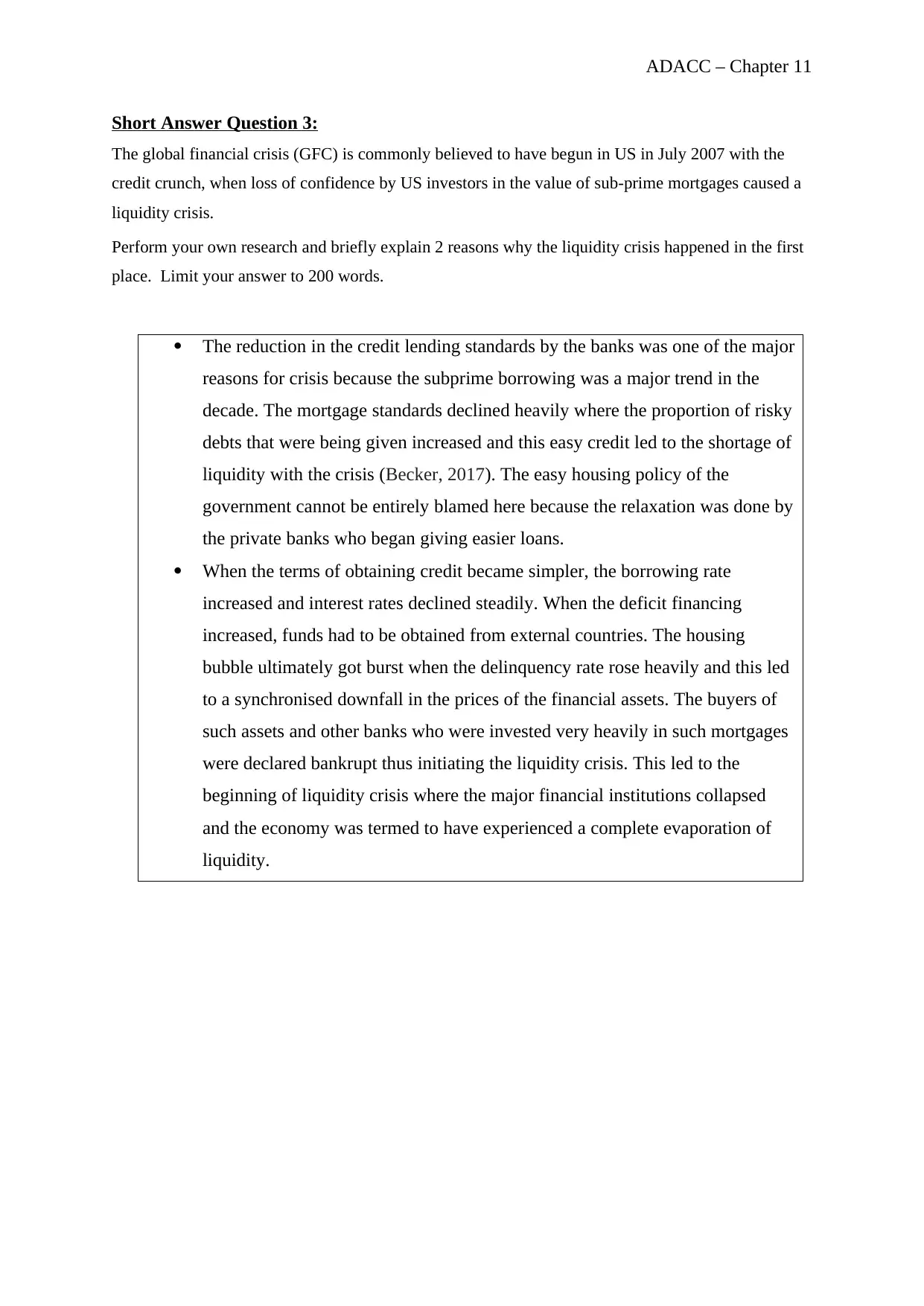
ADACC – Chapter 11
Short Answer Question 3:
The global financial crisis (GFC) is commonly believed to have begun in US in July 2007 with the
credit crunch, when loss of confidence by US investors in the value of sub-prime mortgages caused a
liquidity crisis.
Perform your own research and briefly explain 2 reasons why the liquidity crisis happened in the first
place. Limit your answer to 200 words.
The reduction in the credit lending standards by the banks was one of the major
reasons for crisis because the subprime borrowing was a major trend in the
decade. The mortgage standards declined heavily where the proportion of risky
debts that were being given increased and this easy credit led to the shortage of
liquidity with the crisis (Becker, 2017). The easy housing policy of the
government cannot be entirely blamed here because the relaxation was done by
the private banks who began giving easier loans.
When the terms of obtaining credit became simpler, the borrowing rate
increased and interest rates declined steadily. When the deficit financing
increased, funds had to be obtained from external countries. The housing
bubble ultimately got burst when the delinquency rate rose heavily and this led
to a synchronised downfall in the prices of the financial assets. The buyers of
such assets and other banks who were invested very heavily in such mortgages
were declared bankrupt thus initiating the liquidity crisis. This led to the
beginning of liquidity crisis where the major financial institutions collapsed
and the economy was termed to have experienced a complete evaporation of
liquidity.
Short Answer Question 3:
The global financial crisis (GFC) is commonly believed to have begun in US in July 2007 with the
credit crunch, when loss of confidence by US investors in the value of sub-prime mortgages caused a
liquidity crisis.
Perform your own research and briefly explain 2 reasons why the liquidity crisis happened in the first
place. Limit your answer to 200 words.
The reduction in the credit lending standards by the banks was one of the major
reasons for crisis because the subprime borrowing was a major trend in the
decade. The mortgage standards declined heavily where the proportion of risky
debts that were being given increased and this easy credit led to the shortage of
liquidity with the crisis (Becker, 2017). The easy housing policy of the
government cannot be entirely blamed here because the relaxation was done by
the private banks who began giving easier loans.
When the terms of obtaining credit became simpler, the borrowing rate
increased and interest rates declined steadily. When the deficit financing
increased, funds had to be obtained from external countries. The housing
bubble ultimately got burst when the delinquency rate rose heavily and this led
to a synchronised downfall in the prices of the financial assets. The buyers of
such assets and other banks who were invested very heavily in such mortgages
were declared bankrupt thus initiating the liquidity crisis. This led to the
beginning of liquidity crisis where the major financial institutions collapsed
and the economy was termed to have experienced a complete evaporation of
liquidity.
Paraphrase This Document
Need a fresh take? Get an instant paraphrase of this document with our AI Paraphraser
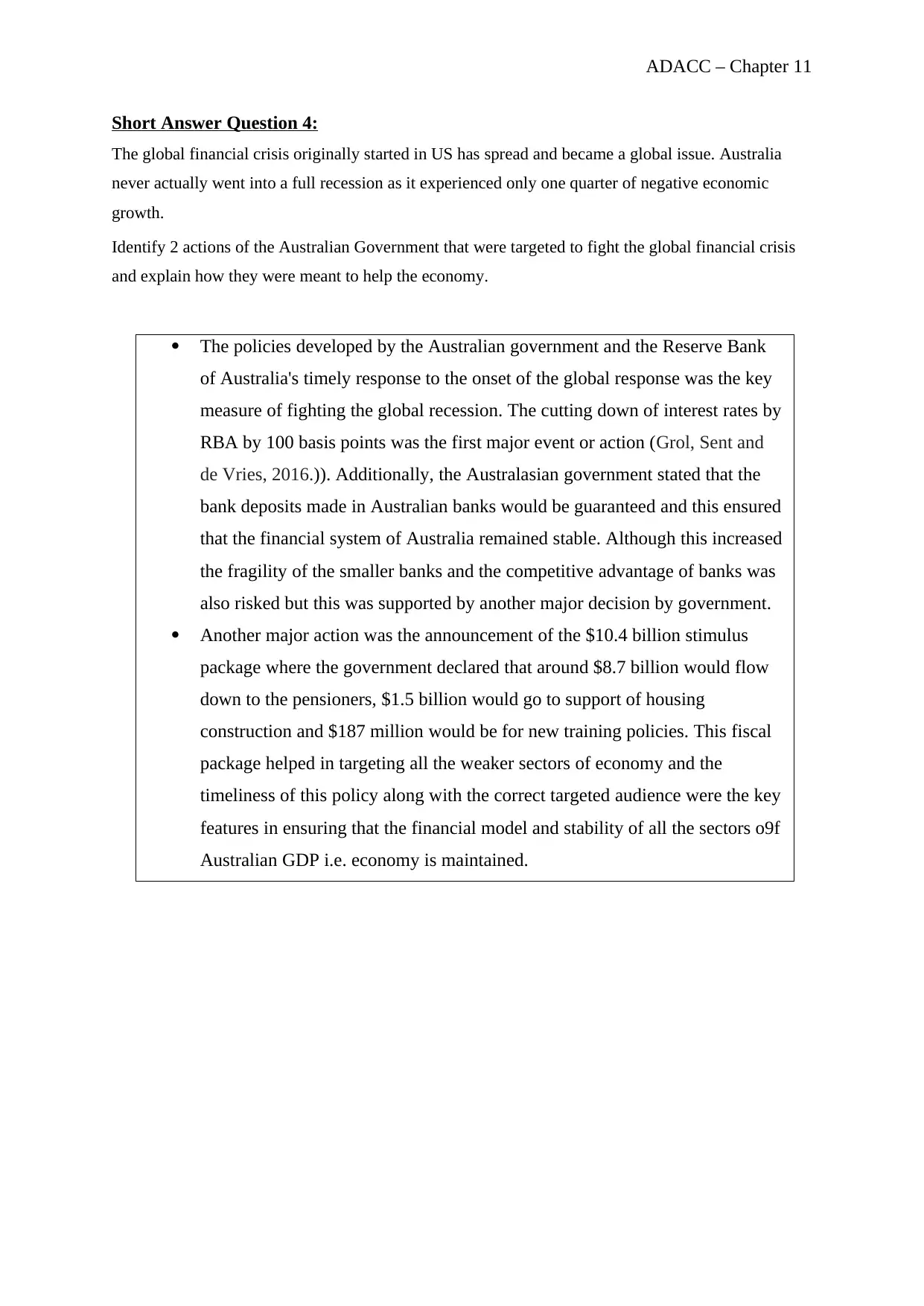
ADACC – Chapter 11
Short Answer Question 4:
The global financial crisis originally started in US has spread and became a global issue. Australia
never actually went into a full recession as it experienced only one quarter of negative economic
growth.
Identify 2 actions of the Australian Government that were targeted to fight the global financial crisis
and explain how they were meant to help the economy.
The policies developed by the Australian government and the Reserve Bank
of Australia's timely response to the onset of the global response was the key
measure of fighting the global recession. The cutting down of interest rates by
RBA by 100 basis points was the first major event or action (Grol, Sent and
de Vries, 2016.)). Additionally, the Australasian government stated that the
bank deposits made in Australian banks would be guaranteed and this ensured
that the financial system of Australia remained stable. Although this increased
the fragility of the smaller banks and the competitive advantage of banks was
also risked but this was supported by another major decision by government.
Another major action was the announcement of the $10.4 billion stimulus
package where the government declared that around $8.7 billion would flow
down to the pensioners, $1.5 billion would go to support of housing
construction and $187 million would be for new training policies. This fiscal
package helped in targeting all the weaker sectors of economy and the
timeliness of this policy along with the correct targeted audience were the key
features in ensuring that the financial model and stability of all the sectors o9f
Australian GDP i.e. economy is maintained.
Short Answer Question 4:
The global financial crisis originally started in US has spread and became a global issue. Australia
never actually went into a full recession as it experienced only one quarter of negative economic
growth.
Identify 2 actions of the Australian Government that were targeted to fight the global financial crisis
and explain how they were meant to help the economy.
The policies developed by the Australian government and the Reserve Bank
of Australia's timely response to the onset of the global response was the key
measure of fighting the global recession. The cutting down of interest rates by
RBA by 100 basis points was the first major event or action (Grol, Sent and
de Vries, 2016.)). Additionally, the Australasian government stated that the
bank deposits made in Australian banks would be guaranteed and this ensured
that the financial system of Australia remained stable. Although this increased
the fragility of the smaller banks and the competitive advantage of banks was
also risked but this was supported by another major decision by government.
Another major action was the announcement of the $10.4 billion stimulus
package where the government declared that around $8.7 billion would flow
down to the pensioners, $1.5 billion would go to support of housing
construction and $187 million would be for new training policies. This fiscal
package helped in targeting all the weaker sectors of economy and the
timeliness of this policy along with the correct targeted audience were the key
features in ensuring that the financial model and stability of all the sectors o9f
Australian GDP i.e. economy is maintained.
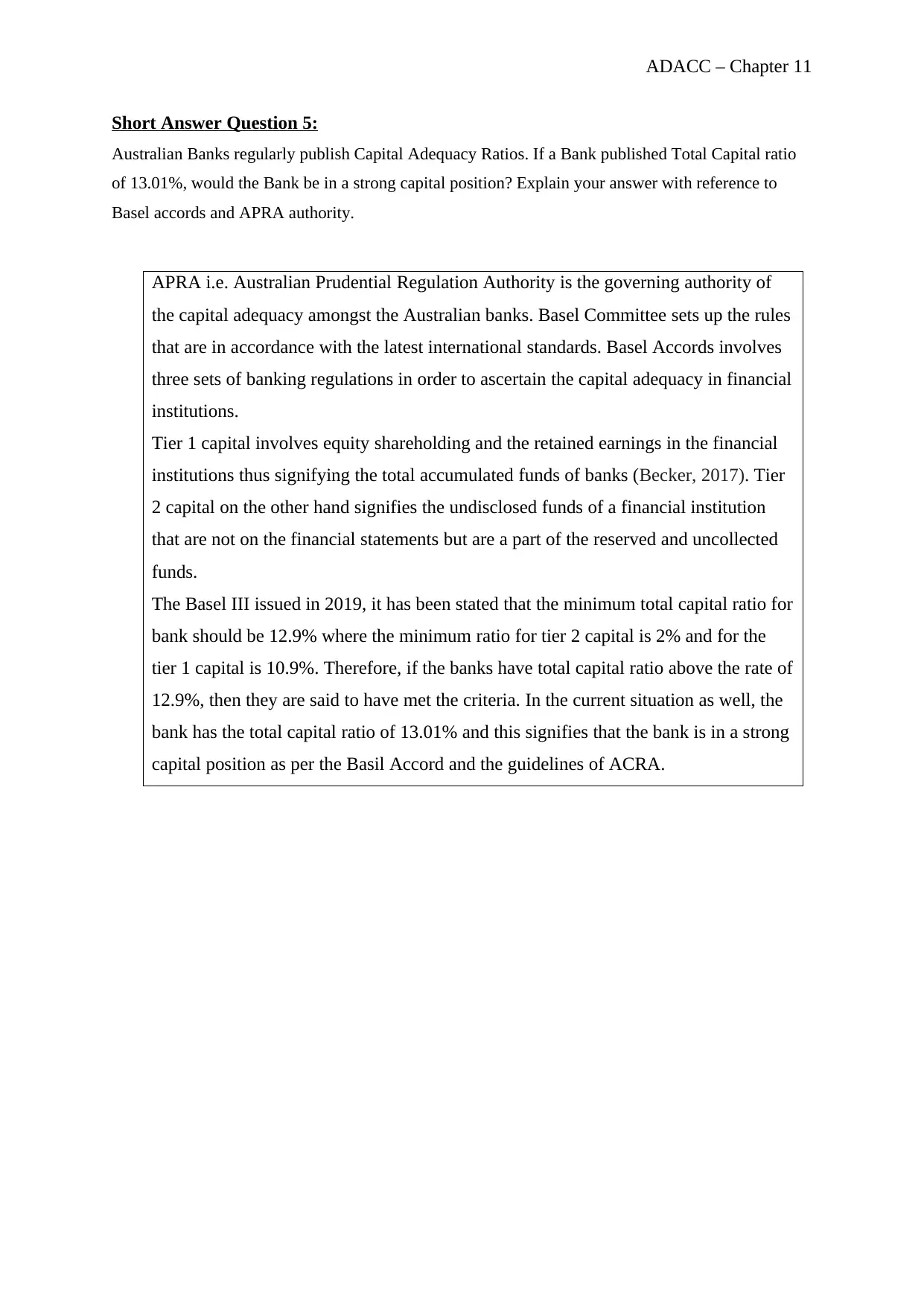
ADACC – Chapter 11
Short Answer Question 5:
Australian Banks regularly publish Capital Adequacy Ratios. If a Bank published Total Capital ratio
of 13.01%, would the Bank be in a strong capital position? Explain your answer with reference to
Basel accords and APRA authority.
APRA i.e. Australian Prudential Regulation Authority is the governing authority of
the capital adequacy amongst the Australian banks. Basel Committee sets up the rules
that are in accordance with the latest international standards. Basel Accords involves
three sets of banking regulations in order to ascertain the capital adequacy in financial
institutions.
Tier 1 capital involves equity shareholding and the retained earnings in the financial
institutions thus signifying the total accumulated funds of banks (Becker, 2017). Tier
2 capital on the other hand signifies the undisclosed funds of a financial institution
that are not on the financial statements but are a part of the reserved and uncollected
funds.
The Basel III issued in 2019, it has been stated that the minimum total capital ratio for
bank should be 12.9% where the minimum ratio for tier 2 capital is 2% and for the
tier 1 capital is 10.9%. Therefore, if the banks have total capital ratio above the rate of
12.9%, then they are said to have met the criteria. In the current situation as well, the
bank has the total capital ratio of 13.01% and this signifies that the bank is in a strong
capital position as per the Basil Accord and the guidelines of ACRA.
Short Answer Question 5:
Australian Banks regularly publish Capital Adequacy Ratios. If a Bank published Total Capital ratio
of 13.01%, would the Bank be in a strong capital position? Explain your answer with reference to
Basel accords and APRA authority.
APRA i.e. Australian Prudential Regulation Authority is the governing authority of
the capital adequacy amongst the Australian banks. Basel Committee sets up the rules
that are in accordance with the latest international standards. Basel Accords involves
three sets of banking regulations in order to ascertain the capital adequacy in financial
institutions.
Tier 1 capital involves equity shareholding and the retained earnings in the financial
institutions thus signifying the total accumulated funds of banks (Becker, 2017). Tier
2 capital on the other hand signifies the undisclosed funds of a financial institution
that are not on the financial statements but are a part of the reserved and uncollected
funds.
The Basel III issued in 2019, it has been stated that the minimum total capital ratio for
bank should be 12.9% where the minimum ratio for tier 2 capital is 2% and for the
tier 1 capital is 10.9%. Therefore, if the banks have total capital ratio above the rate of
12.9%, then they are said to have met the criteria. In the current situation as well, the
bank has the total capital ratio of 13.01% and this signifies that the bank is in a strong
capital position as per the Basil Accord and the guidelines of ACRA.
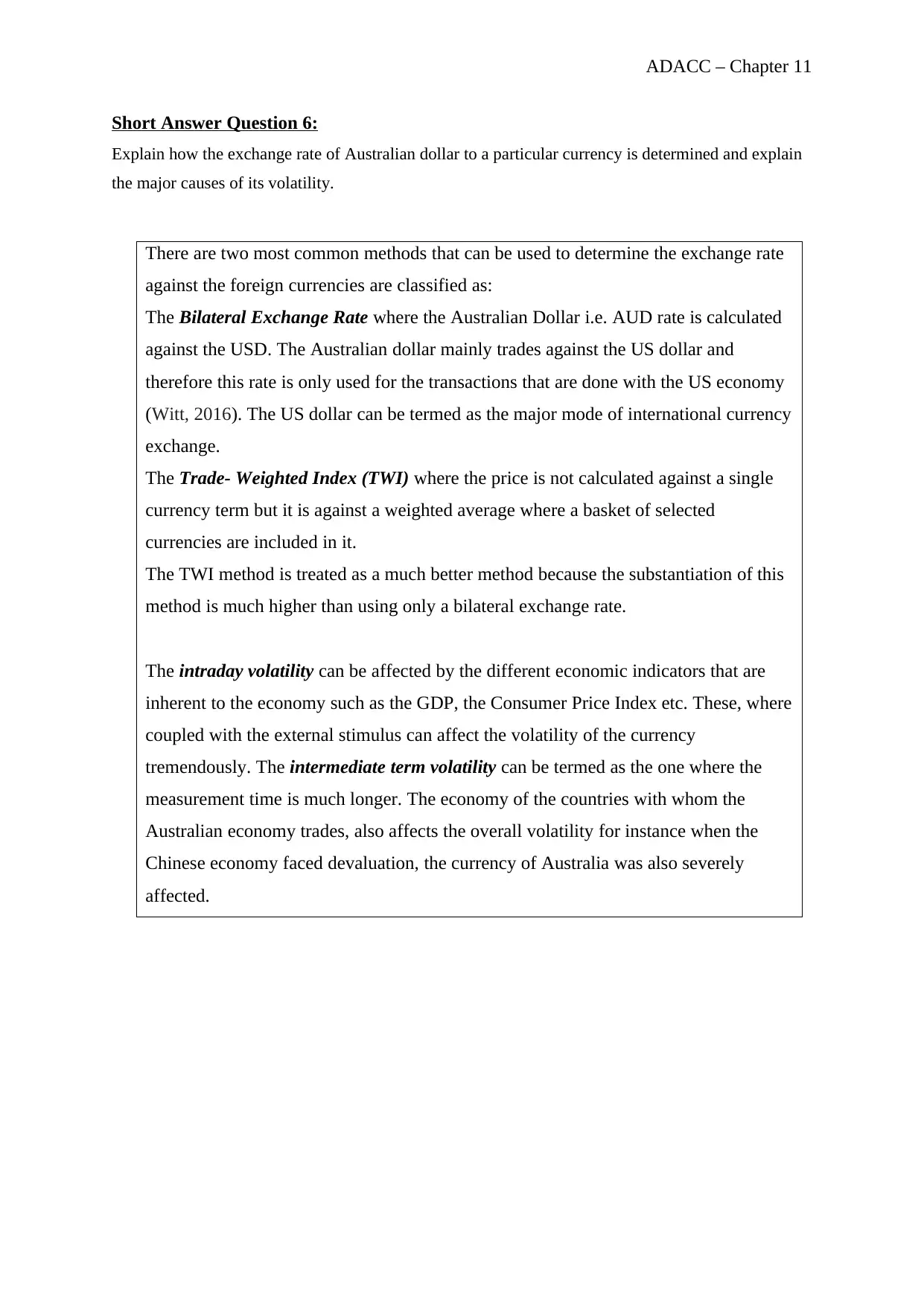
ADACC – Chapter 11
Short Answer Question 6:
Explain how the exchange rate of Australian dollar to a particular currency is determined and explain
the major causes of its volatility.
There are two most common methods that can be used to determine the exchange rate
against the foreign currencies are classified as:
The Bilateral Exchange Rate where the Australian Dollar i.e. AUD rate is calculated
against the USD. The Australian dollar mainly trades against the US dollar and
therefore this rate is only used for the transactions that are done with the US economy
(Witt, 2016). The US dollar can be termed as the major mode of international currency
exchange.
The Trade- Weighted Index (TWI) where the price is not calculated against a single
currency term but it is against a weighted average where a basket of selected
currencies are included in it.
The TWI method is treated as a much better method because the substantiation of this
method is much higher than using only a bilateral exchange rate.
The intraday volatility can be affected by the different economic indicators that are
inherent to the economy such as the GDP, the Consumer Price Index etc. These, where
coupled with the external stimulus can affect the volatility of the currency
tremendously. The intermediate term volatility can be termed as the one where the
measurement time is much longer. The economy of the countries with whom the
Australian economy trades, also affects the overall volatility for instance when the
Chinese economy faced devaluation, the currency of Australia was also severely
affected.
Short Answer Question 6:
Explain how the exchange rate of Australian dollar to a particular currency is determined and explain
the major causes of its volatility.
There are two most common methods that can be used to determine the exchange rate
against the foreign currencies are classified as:
The Bilateral Exchange Rate where the Australian Dollar i.e. AUD rate is calculated
against the USD. The Australian dollar mainly trades against the US dollar and
therefore this rate is only used for the transactions that are done with the US economy
(Witt, 2016). The US dollar can be termed as the major mode of international currency
exchange.
The Trade- Weighted Index (TWI) where the price is not calculated against a single
currency term but it is against a weighted average where a basket of selected
currencies are included in it.
The TWI method is treated as a much better method because the substantiation of this
method is much higher than using only a bilateral exchange rate.
The intraday volatility can be affected by the different economic indicators that are
inherent to the economy such as the GDP, the Consumer Price Index etc. These, where
coupled with the external stimulus can affect the volatility of the currency
tremendously. The intermediate term volatility can be termed as the one where the
measurement time is much longer. The economy of the countries with whom the
Australian economy trades, also affects the overall volatility for instance when the
Chinese economy faced devaluation, the currency of Australia was also severely
affected.
Secure Best Marks with AI Grader
Need help grading? Try our AI Grader for instant feedback on your assignments.
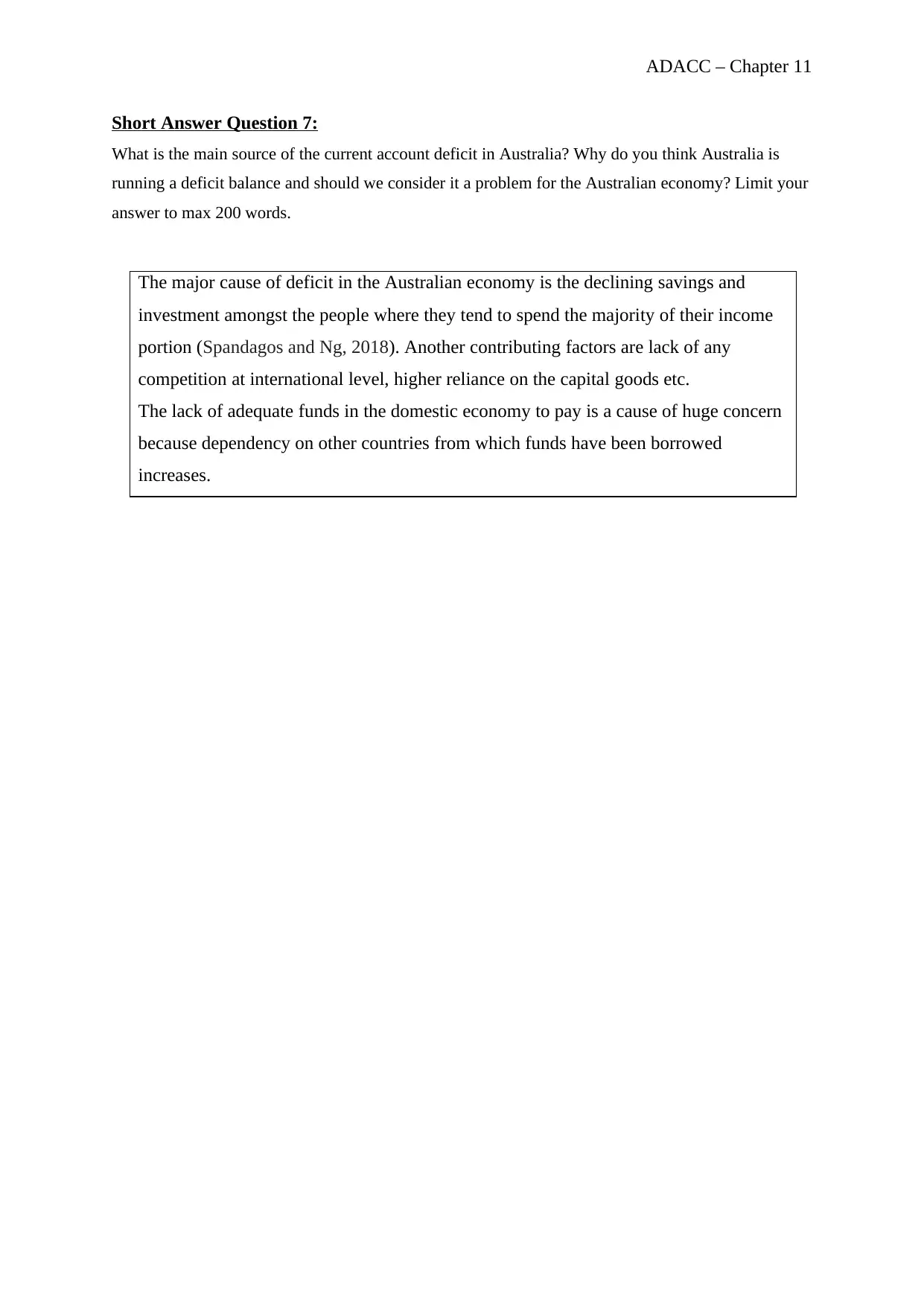
ADACC – Chapter 11
Short Answer Question 7:
What is the main source of the current account deficit in Australia? Why do you think Australia is
running a deficit balance and should we consider it a problem for the Australian economy? Limit your
answer to max 200 words.
The major cause of deficit in the Australian economy is the declining savings and
investment amongst the people where they tend to spend the majority of their income
portion (Spandagos and Ng, 2018). Another contributing factors are lack of any
competition at international level, higher reliance on the capital goods etc.
The lack of adequate funds in the domestic economy to pay is a cause of huge concern
because dependency on other countries from which funds have been borrowed
increases.
Short Answer Question 7:
What is the main source of the current account deficit in Australia? Why do you think Australia is
running a deficit balance and should we consider it a problem for the Australian economy? Limit your
answer to max 200 words.
The major cause of deficit in the Australian economy is the declining savings and
investment amongst the people where they tend to spend the majority of their income
portion (Spandagos and Ng, 2018). Another contributing factors are lack of any
competition at international level, higher reliance on the capital goods etc.
The lack of adequate funds in the domestic economy to pay is a cause of huge concern
because dependency on other countries from which funds have been borrowed
increases.
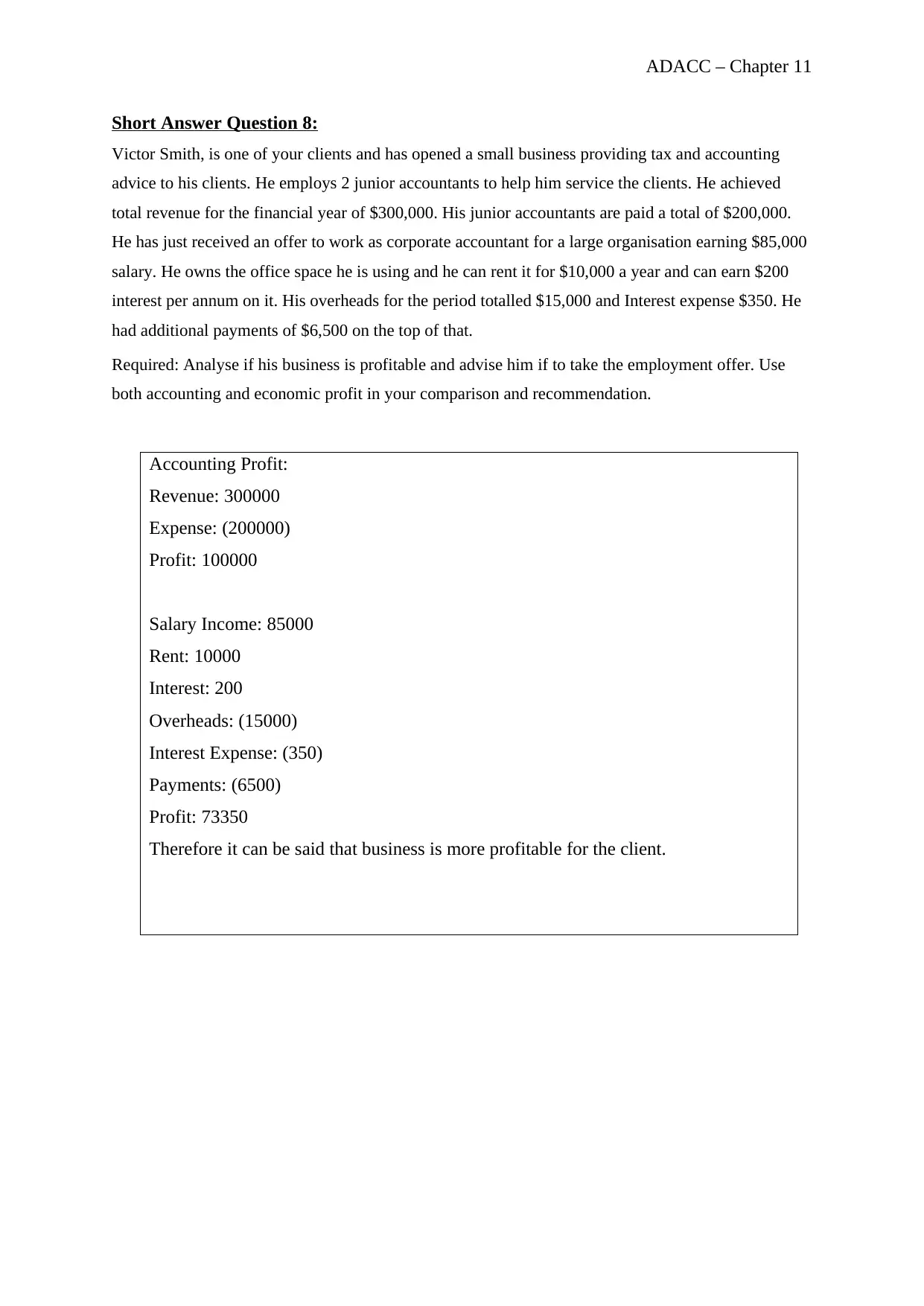
ADACC – Chapter 11
Short Answer Question 8:
Victor Smith, is one of your clients and has opened a small business providing tax and accounting
advice to his clients. He employs 2 junior accountants to help him service the clients. He achieved
total revenue for the financial year of $300,000. His junior accountants are paid a total of $200,000.
He has just received an offer to work as corporate accountant for a large organisation earning $85,000
salary. He owns the office space he is using and he can rent it for $10,000 a year and can earn $200
interest per annum on it. His overheads for the period totalled $15,000 and Interest expense $350. He
had additional payments of $6,500 on the top of that.
Required: Analyse if his business is profitable and advise him if to take the employment offer. Use
both accounting and economic profit in your comparison and recommendation.
Accounting Profit:
Revenue: 300000
Expense: (200000)
Profit: 100000
Salary Income: 85000
Rent: 10000
Interest: 200
Overheads: (15000)
Interest Expense: (350)
Payments: (6500)
Profit: 73350
Therefore it can be said that business is more profitable for the client.
Short Answer Question 8:
Victor Smith, is one of your clients and has opened a small business providing tax and accounting
advice to his clients. He employs 2 junior accountants to help him service the clients. He achieved
total revenue for the financial year of $300,000. His junior accountants are paid a total of $200,000.
He has just received an offer to work as corporate accountant for a large organisation earning $85,000
salary. He owns the office space he is using and he can rent it for $10,000 a year and can earn $200
interest per annum on it. His overheads for the period totalled $15,000 and Interest expense $350. He
had additional payments of $6,500 on the top of that.
Required: Analyse if his business is profitable and advise him if to take the employment offer. Use
both accounting and economic profit in your comparison and recommendation.
Accounting Profit:
Revenue: 300000
Expense: (200000)
Profit: 100000
Salary Income: 85000
Rent: 10000
Interest: 200
Overheads: (15000)
Interest Expense: (350)
Payments: (6500)
Profit: 73350
Therefore it can be said that business is more profitable for the client.
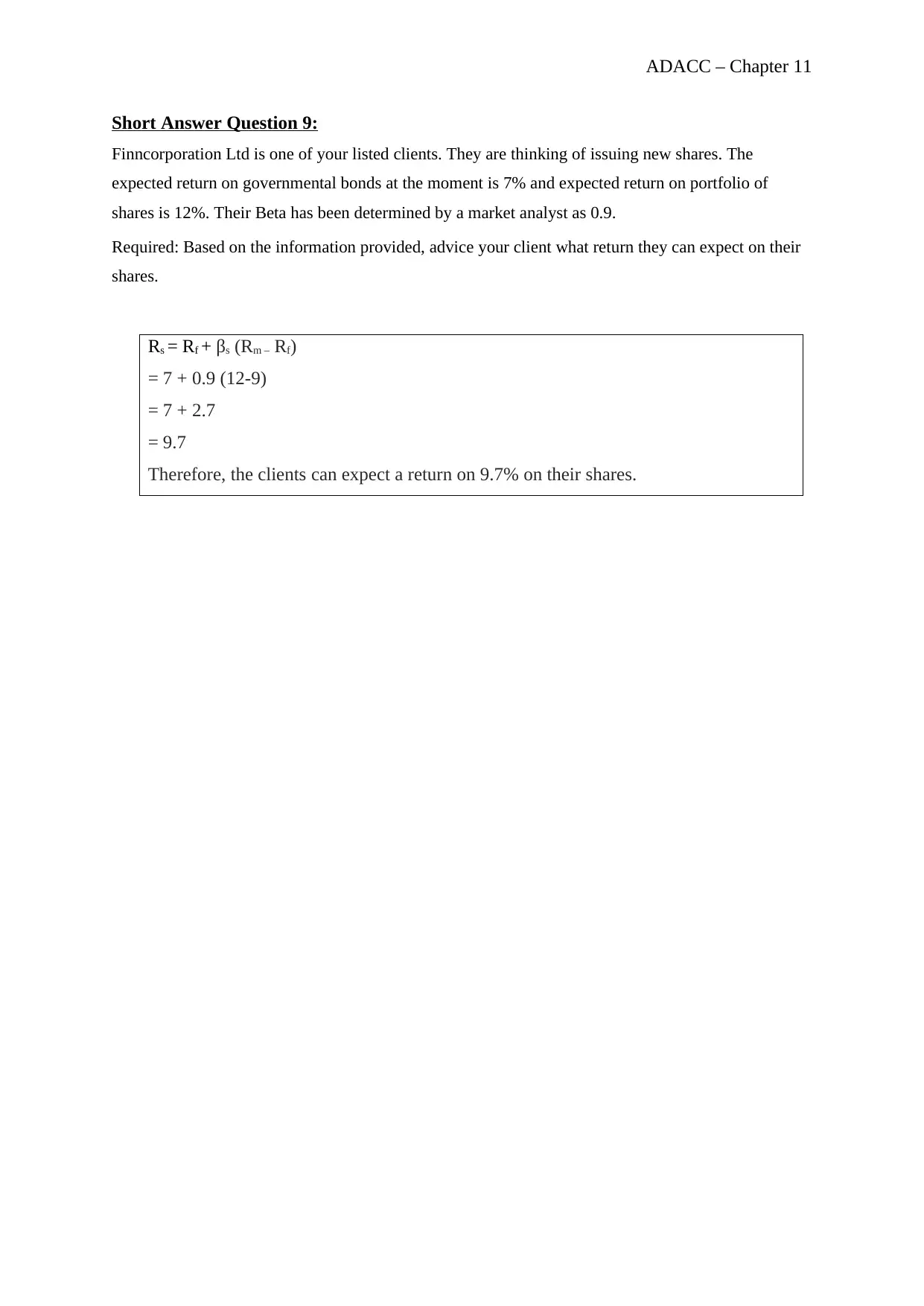
ADACC – Chapter 11
Short Answer Question 9:
Finncorporation Ltd is one of your listed clients. They are thinking of issuing new shares. The
expected return on governmental bonds at the moment is 7% and expected return on portfolio of
shares is 12%. Their Beta has been determined by a market analyst as 0.9.
Required: Based on the information provided, advice your client what return they can expect on their
shares.
Rs = Rf + βs (Rm – Rf)
= 7 + 0.9 (12-9)
= 7 + 2.7
= 9.7
Therefore, the clients can expect a return on 9.7% on their shares.
Short Answer Question 9:
Finncorporation Ltd is one of your listed clients. They are thinking of issuing new shares. The
expected return on governmental bonds at the moment is 7% and expected return on portfolio of
shares is 12%. Their Beta has been determined by a market analyst as 0.9.
Required: Based on the information provided, advice your client what return they can expect on their
shares.
Rs = Rf + βs (Rm – Rf)
= 7 + 0.9 (12-9)
= 7 + 2.7
= 9.7
Therefore, the clients can expect a return on 9.7% on their shares.
Paraphrase This Document
Need a fresh take? Get an instant paraphrase of this document with our AI Paraphraser
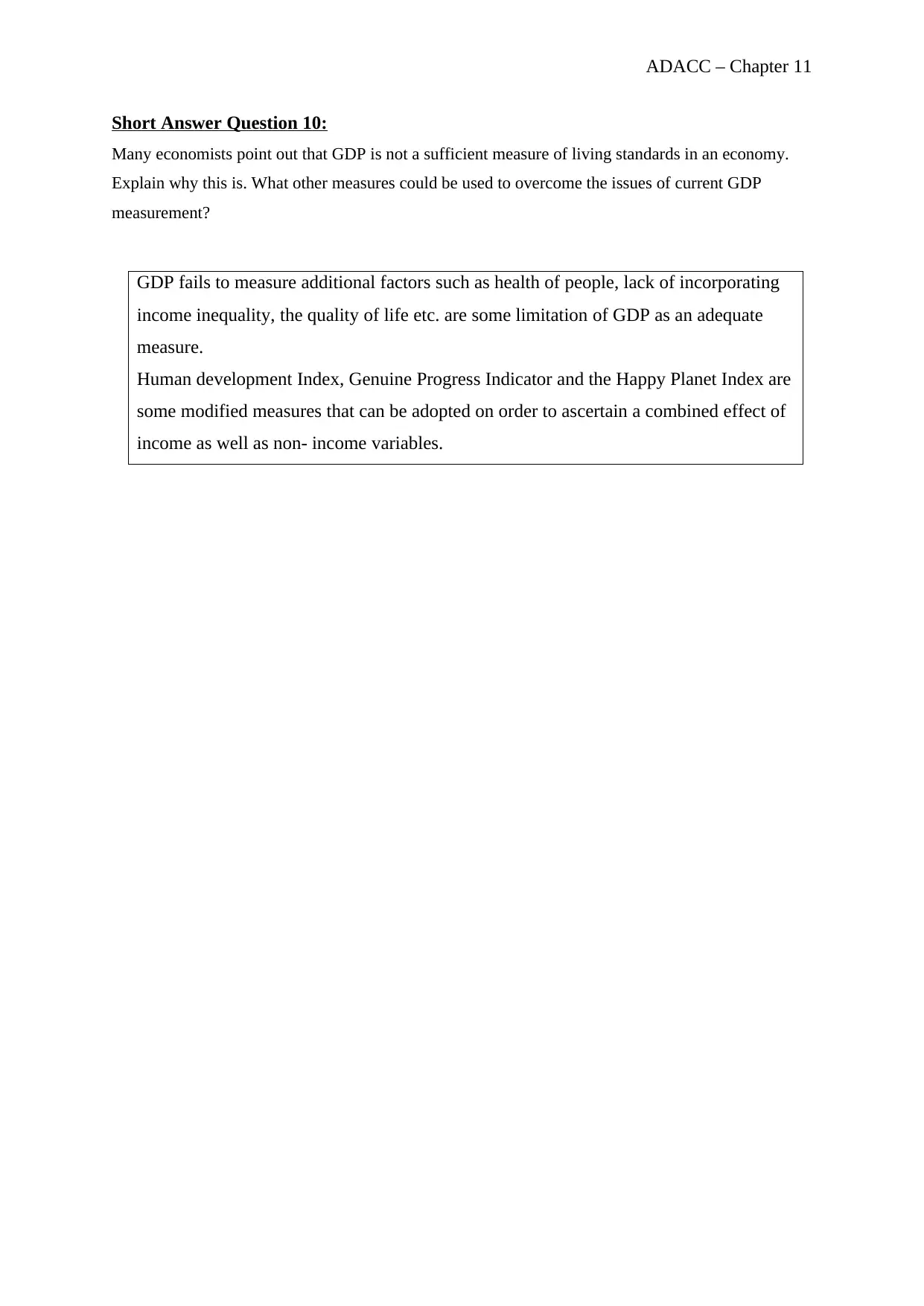
ADACC – Chapter 11
Short Answer Question 10:
Many economists point out that GDP is not a sufficient measure of living standards in an economy.
Explain why this is. What other measures could be used to overcome the issues of current GDP
measurement?
GDP fails to measure additional factors such as health of people, lack of incorporating
income inequality, the quality of life etc. are some limitation of GDP as an adequate
measure.
Human development Index, Genuine Progress Indicator and the Happy Planet Index are
some modified measures that can be adopted on order to ascertain a combined effect of
income as well as non- income variables.
Short Answer Question 10:
Many economists point out that GDP is not a sufficient measure of living standards in an economy.
Explain why this is. What other measures could be used to overcome the issues of current GDP
measurement?
GDP fails to measure additional factors such as health of people, lack of incorporating
income inequality, the quality of life etc. are some limitation of GDP as an adequate
measure.
Human development Index, Genuine Progress Indicator and the Happy Planet Index are
some modified measures that can be adopted on order to ascertain a combined effect of
income as well as non- income variables.
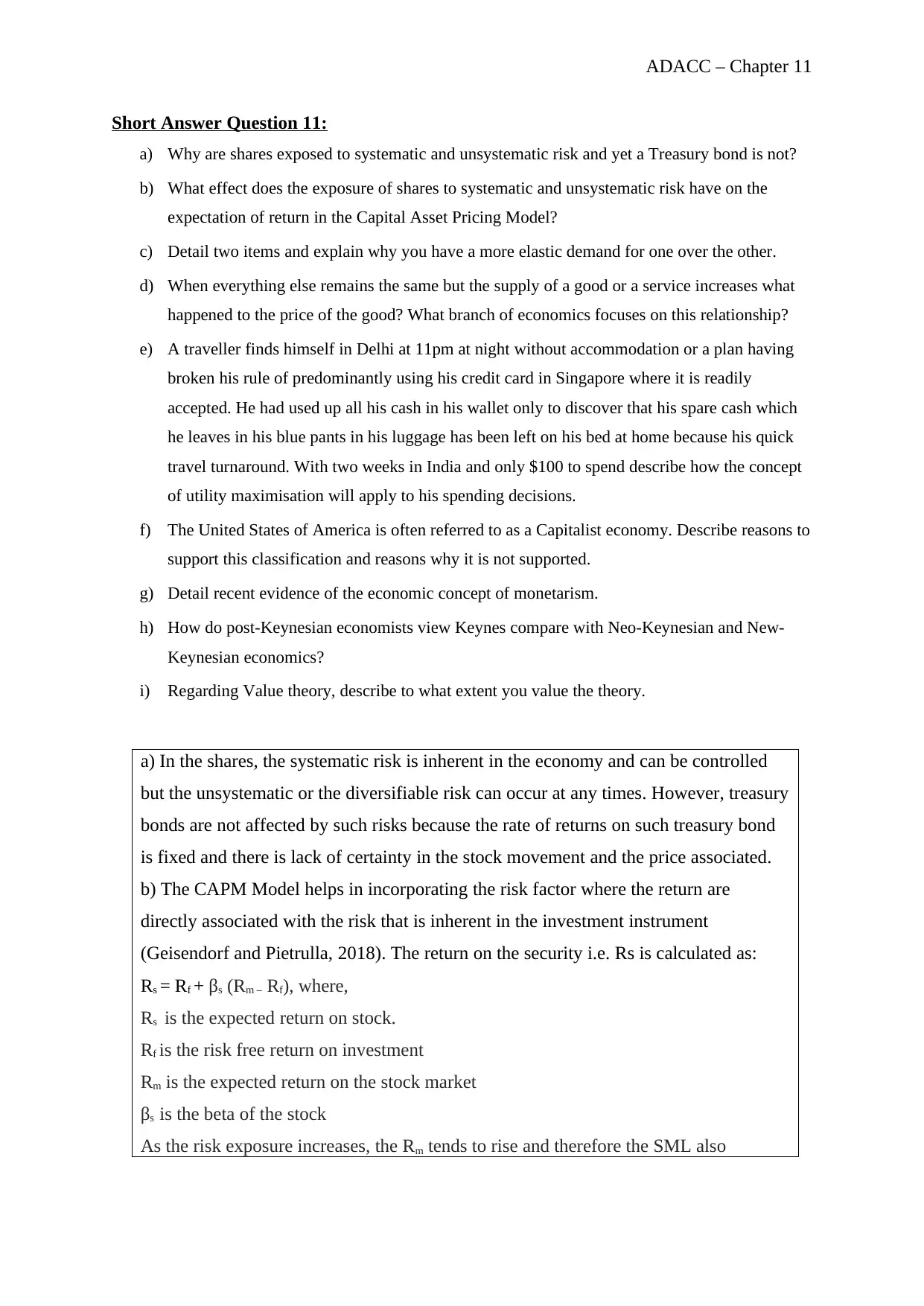
ADACC – Chapter 11
Short Answer Question 11:
a) Why are shares exposed to systematic and unsystematic risk and yet a Treasury bond is not?
b) What effect does the exposure of shares to systematic and unsystematic risk have on the
expectation of return in the Capital Asset Pricing Model?
c) Detail two items and explain why you have a more elastic demand for one over the other.
d) When everything else remains the same but the supply of a good or a service increases what
happened to the price of the good? What branch of economics focuses on this relationship?
e) A traveller finds himself in Delhi at 11pm at night without accommodation or a plan having
broken his rule of predominantly using his credit card in Singapore where it is readily
accepted. He had used up all his cash in his wallet only to discover that his spare cash which
he leaves in his blue pants in his luggage has been left on his bed at home because his quick
travel turnaround. With two weeks in India and only $100 to spend describe how the concept
of utility maximisation will apply to his spending decisions.
f) The United States of America is often referred to as a Capitalist economy. Describe reasons to
support this classification and reasons why it is not supported.
g) Detail recent evidence of the economic concept of monetarism.
h) How do post-Keynesian economists view Keynes compare with Neo-Keynesian and New-
Keynesian economics?
i) Regarding Value theory, describe to what extent you value the theory.
a) In the shares, the systematic risk is inherent in the economy and can be controlled
but the unsystematic or the diversifiable risk can occur at any times. However, treasury
bonds are not affected by such risks because the rate of returns on such treasury bond
is fixed and there is lack of certainty in the stock movement and the price associated.
b) The CAPM Model helps in incorporating the risk factor where the return are
directly associated with the risk that is inherent in the investment instrument
(Geisendorf and Pietrulla, 2018). The return on the security i.e. Rs is calculated as:
Rs = Rf + βs (Rm – Rf), where,
Rs is the expected return on stock.
Rf is the risk free return on investment
Rm is the expected return on the stock market
βs is the beta of the stock
As the risk exposure increases, the Rm tends to rise and therefore the SML also
Short Answer Question 11:
a) Why are shares exposed to systematic and unsystematic risk and yet a Treasury bond is not?
b) What effect does the exposure of shares to systematic and unsystematic risk have on the
expectation of return in the Capital Asset Pricing Model?
c) Detail two items and explain why you have a more elastic demand for one over the other.
d) When everything else remains the same but the supply of a good or a service increases what
happened to the price of the good? What branch of economics focuses on this relationship?
e) A traveller finds himself in Delhi at 11pm at night without accommodation or a plan having
broken his rule of predominantly using his credit card in Singapore where it is readily
accepted. He had used up all his cash in his wallet only to discover that his spare cash which
he leaves in his blue pants in his luggage has been left on his bed at home because his quick
travel turnaround. With two weeks in India and only $100 to spend describe how the concept
of utility maximisation will apply to his spending decisions.
f) The United States of America is often referred to as a Capitalist economy. Describe reasons to
support this classification and reasons why it is not supported.
g) Detail recent evidence of the economic concept of monetarism.
h) How do post-Keynesian economists view Keynes compare with Neo-Keynesian and New-
Keynesian economics?
i) Regarding Value theory, describe to what extent you value the theory.
a) In the shares, the systematic risk is inherent in the economy and can be controlled
but the unsystematic or the diversifiable risk can occur at any times. However, treasury
bonds are not affected by such risks because the rate of returns on such treasury bond
is fixed and there is lack of certainty in the stock movement and the price associated.
b) The CAPM Model helps in incorporating the risk factor where the return are
directly associated with the risk that is inherent in the investment instrument
(Geisendorf and Pietrulla, 2018). The return on the security i.e. Rs is calculated as:
Rs = Rf + βs (Rm – Rf), where,
Rs is the expected return on stock.
Rf is the risk free return on investment
Rm is the expected return on the stock market
βs is the beta of the stock
As the risk exposure increases, the Rm tends to rise and therefore the SML also
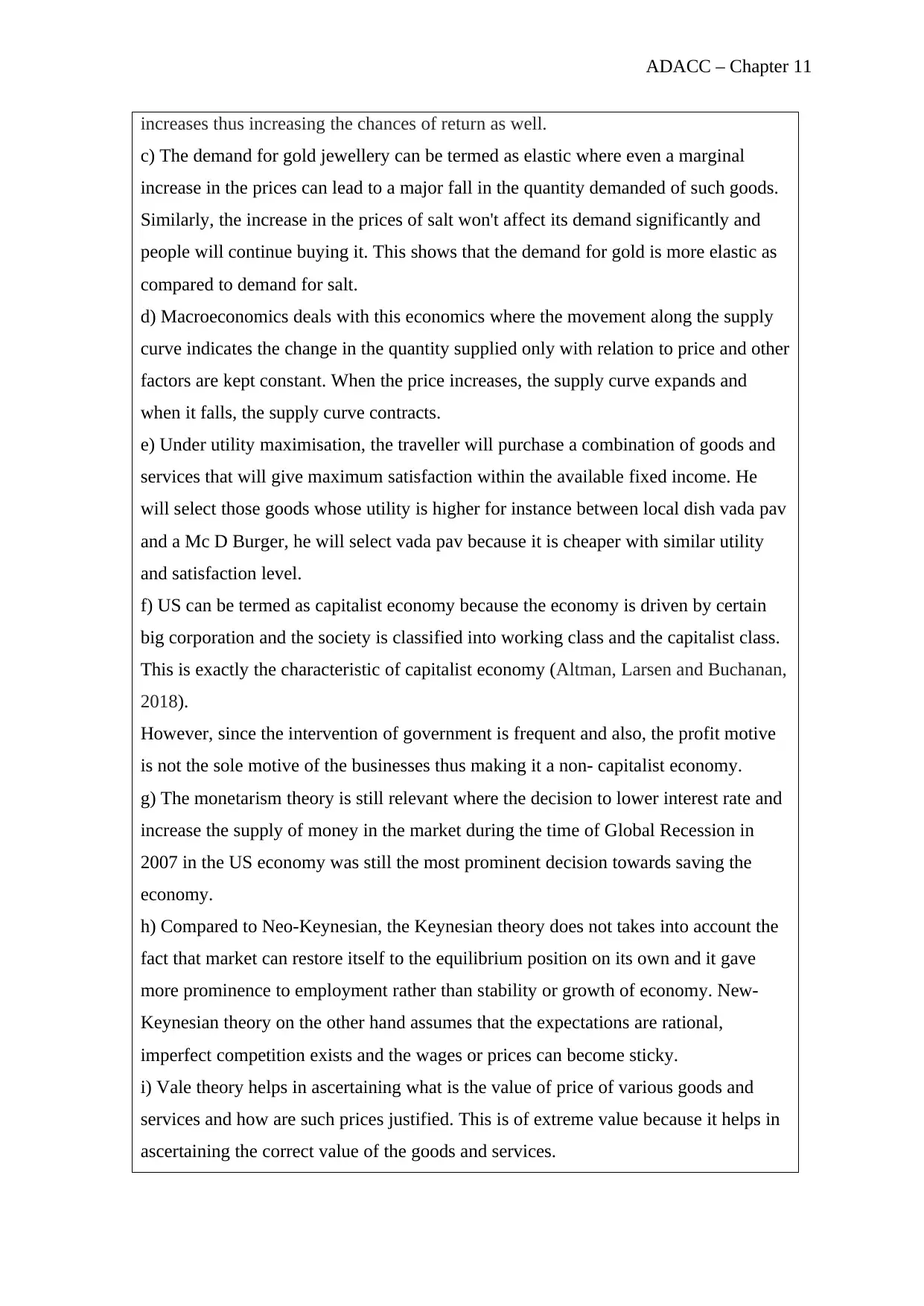
ADACC – Chapter 11
increases thus increasing the chances of return as well.
c) The demand for gold jewellery can be termed as elastic where even a marginal
increase in the prices can lead to a major fall in the quantity demanded of such goods.
Similarly, the increase in the prices of salt won't affect its demand significantly and
people will continue buying it. This shows that the demand for gold is more elastic as
compared to demand for salt.
d) Macroeconomics deals with this economics where the movement along the supply
curve indicates the change in the quantity supplied only with relation to price and other
factors are kept constant. When the price increases, the supply curve expands and
when it falls, the supply curve contracts.
e) Under utility maximisation, the traveller will purchase a combination of goods and
services that will give maximum satisfaction within the available fixed income. He
will select those goods whose utility is higher for instance between local dish vada pav
and a Mc D Burger, he will select vada pav because it is cheaper with similar utility
and satisfaction level.
f) US can be termed as capitalist economy because the economy is driven by certain
big corporation and the society is classified into working class and the capitalist class.
This is exactly the characteristic of capitalist economy (Altman, Larsen and Buchanan,
2018).
However, since the intervention of government is frequent and also, the profit motive
is not the sole motive of the businesses thus making it a non- capitalist economy.
g) The monetarism theory is still relevant where the decision to lower interest rate and
increase the supply of money in the market during the time of Global Recession in
2007 in the US economy was still the most prominent decision towards saving the
economy.
h) Compared to Neo-Keynesian, the Keynesian theory does not takes into account the
fact that market can restore itself to the equilibrium position on its own and it gave
more prominence to employment rather than stability or growth of economy. New-
Keynesian theory on the other hand assumes that the expectations are rational,
imperfect competition exists and the wages or prices can become sticky.
i) Vale theory helps in ascertaining what is the value of price of various goods and
services and how are such prices justified. This is of extreme value because it helps in
ascertaining the correct value of the goods and services.
increases thus increasing the chances of return as well.
c) The demand for gold jewellery can be termed as elastic where even a marginal
increase in the prices can lead to a major fall in the quantity demanded of such goods.
Similarly, the increase in the prices of salt won't affect its demand significantly and
people will continue buying it. This shows that the demand for gold is more elastic as
compared to demand for salt.
d) Macroeconomics deals with this economics where the movement along the supply
curve indicates the change in the quantity supplied only with relation to price and other
factors are kept constant. When the price increases, the supply curve expands and
when it falls, the supply curve contracts.
e) Under utility maximisation, the traveller will purchase a combination of goods and
services that will give maximum satisfaction within the available fixed income. He
will select those goods whose utility is higher for instance between local dish vada pav
and a Mc D Burger, he will select vada pav because it is cheaper with similar utility
and satisfaction level.
f) US can be termed as capitalist economy because the economy is driven by certain
big corporation and the society is classified into working class and the capitalist class.
This is exactly the characteristic of capitalist economy (Altman, Larsen and Buchanan,
2018).
However, since the intervention of government is frequent and also, the profit motive
is not the sole motive of the businesses thus making it a non- capitalist economy.
g) The monetarism theory is still relevant where the decision to lower interest rate and
increase the supply of money in the market during the time of Global Recession in
2007 in the US economy was still the most prominent decision towards saving the
economy.
h) Compared to Neo-Keynesian, the Keynesian theory does not takes into account the
fact that market can restore itself to the equilibrium position on its own and it gave
more prominence to employment rather than stability or growth of economy. New-
Keynesian theory on the other hand assumes that the expectations are rational,
imperfect competition exists and the wages or prices can become sticky.
i) Vale theory helps in ascertaining what is the value of price of various goods and
services and how are such prices justified. This is of extreme value because it helps in
ascertaining the correct value of the goods and services.
Secure Best Marks with AI Grader
Need help grading? Try our AI Grader for instant feedback on your assignments.

ADACC – Chapter 11
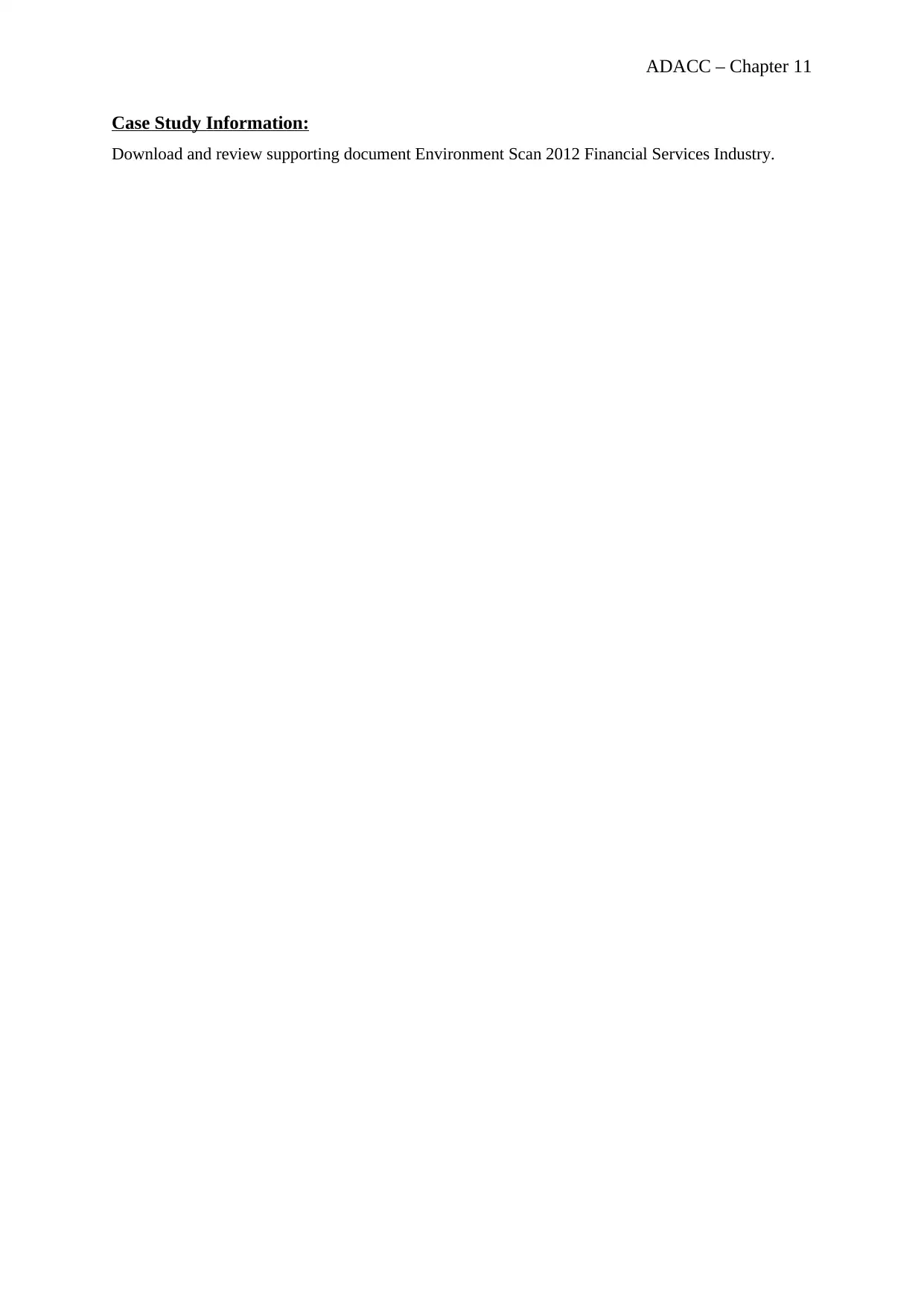
ADACC – Chapter 11
Case Study Information:
Download and review supporting document Environment Scan 2012 Financial Services Industry.
Case Study Information:
Download and review supporting document Environment Scan 2012 Financial Services Industry.
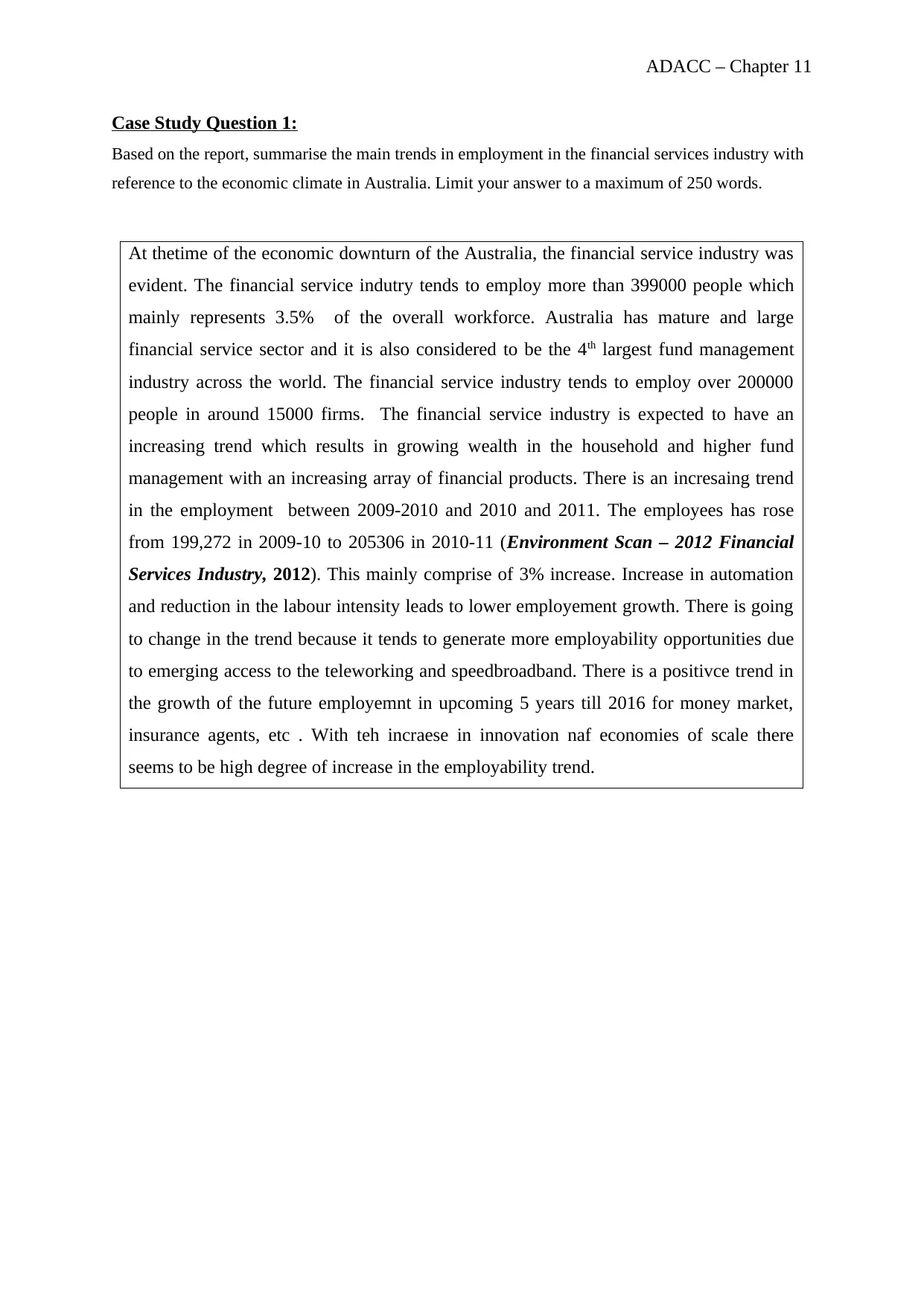
ADACC – Chapter 11
Case Study Question 1:
Based on the report, summarise the main trends in employment in the financial services industry with
reference to the economic climate in Australia. Limit your answer to a maximum of 250 words.
At thetime of the economic downturn of the Australia, the financial service industry was
evident. The financial service indutry tends to employ more than 399000 people which
mainly represents 3.5% of the overall workforce. Australia has mature and large
financial service sector and it is also considered to be the 4th largest fund management
industry across the world. The financial service industry tends to employ over 200000
people in around 15000 firms. The financial service industry is expected to have an
increasing trend which results in growing wealth in the household and higher fund
management with an increasing array of financial products. There is an incresaing trend
in the employment between 2009-2010 and 2010 and 2011. The employees has rose
from 199,272 in 2009-10 to 205306 in 2010-11 (Environment Scan – 2012 Financial
Services Industry, 2012). This mainly comprise of 3% increase. Increase in automation
and reduction in the labour intensity leads to lower employement growth. There is going
to change in the trend because it tends to generate more employability opportunities due
to emerging access to the teleworking and speedbroadband. There is a positivce trend in
the growth of the future employemnt in upcoming 5 years till 2016 for money market,
insurance agents, etc . With teh incraese in innovation naf economies of scale there
seems to be high degree of increase in the employability trend.
Case Study Question 1:
Based on the report, summarise the main trends in employment in the financial services industry with
reference to the economic climate in Australia. Limit your answer to a maximum of 250 words.
At thetime of the economic downturn of the Australia, the financial service industry was
evident. The financial service indutry tends to employ more than 399000 people which
mainly represents 3.5% of the overall workforce. Australia has mature and large
financial service sector and it is also considered to be the 4th largest fund management
industry across the world. The financial service industry tends to employ over 200000
people in around 15000 firms. The financial service industry is expected to have an
increasing trend which results in growing wealth in the household and higher fund
management with an increasing array of financial products. There is an incresaing trend
in the employment between 2009-2010 and 2010 and 2011. The employees has rose
from 199,272 in 2009-10 to 205306 in 2010-11 (Environment Scan – 2012 Financial
Services Industry, 2012). This mainly comprise of 3% increase. Increase in automation
and reduction in the labour intensity leads to lower employement growth. There is going
to change in the trend because it tends to generate more employability opportunities due
to emerging access to the teleworking and speedbroadband. There is a positivce trend in
the growth of the future employemnt in upcoming 5 years till 2016 for money market,
insurance agents, etc . With teh incraese in innovation naf economies of scale there
seems to be high degree of increase in the employability trend.
Paraphrase This Document
Need a fresh take? Get an instant paraphrase of this document with our AI Paraphraser

ADACC – Chapter 11
Case Study Question 2:
Based on the report, what are the main issues financial services sector is facing in relation to labour
productivity?
In Australia, labopur productvity growth has slowed down in the recent years. Decline in
the performance of the labour productivity tends to result in cyclical and special factors
which in turn is attributable to global financial weakness nad downturn of the growth of
GDP . A decline in the financial service sector which in turn is considered to be partly
due because of the structural change infinancila sector. This in turn leads to rising issues
related with financial deregulation, high cost associated with the intensive technology,
etc. The labour productivity of the Australia in turn has increased from 0.86% in Sept
2019 when compared with the drop of around 1.096% in the last quarter. Lower
productivity growth in turn gives rise to lower of employability rate (Environment Scan
– 2012 Financial Services Industry, 2012).
Case Study Question 2:
Based on the report, what are the main issues financial services sector is facing in relation to labour
productivity?
In Australia, labopur productvity growth has slowed down in the recent years. Decline in
the performance of the labour productivity tends to result in cyclical and special factors
which in turn is attributable to global financial weakness nad downturn of the growth of
GDP . A decline in the financial service sector which in turn is considered to be partly
due because of the structural change infinancila sector. This in turn leads to rising issues
related with financial deregulation, high cost associated with the intensive technology,
etc. The labour productivity of the Australia in turn has increased from 0.86% in Sept
2019 when compared with the drop of around 1.096% in the last quarter. Lower
productivity growth in turn gives rise to lower of employability rate (Environment Scan
– 2012 Financial Services Industry, 2012).
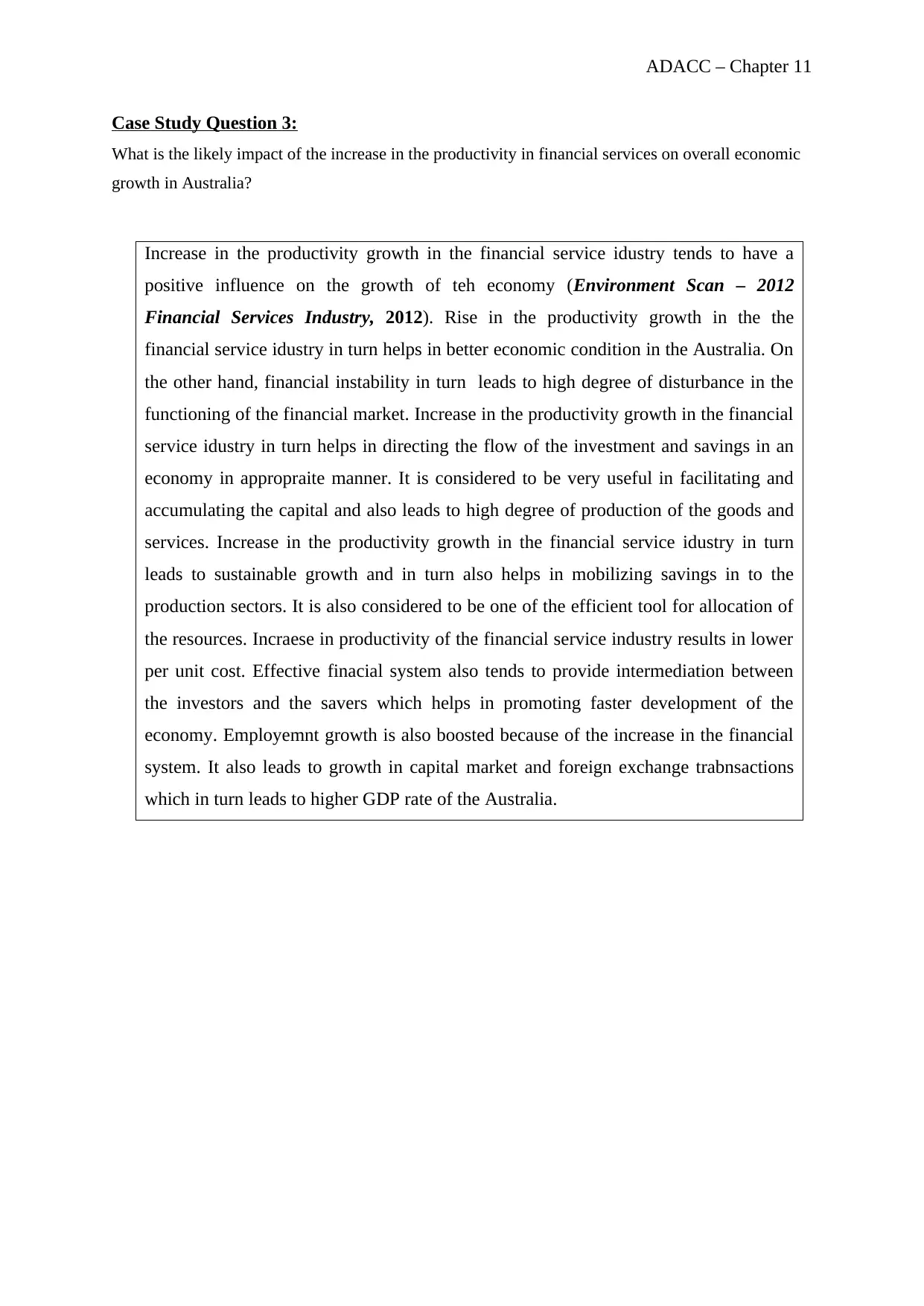
ADACC – Chapter 11
Case Study Question 3:
What is the likely impact of the increase in the productivity in financial services on overall economic
growth in Australia?
Increase in the productivity growth in the financial service idustry tends to have a
positive influence on the growth of teh economy (Environment Scan – 2012
Financial Services Industry, 2012). Rise in the productivity growth in the the
financial service idustry in turn helps in better economic condition in the Australia. On
the other hand, financial instability in turn leads to high degree of disturbance in the
functioning of the financial market. Increase in the productivity growth in the financial
service idustry in turn helps in directing the flow of the investment and savings in an
economy in appropraite manner. It is considered to be very useful in facilitating and
accumulating the capital and also leads to high degree of production of the goods and
services. Increase in the productivity growth in the financial service idustry in turn
leads to sustainable growth and in turn also helps in mobilizing savings in to the
production sectors. It is also considered to be one of the efficient tool for allocation of
the resources. Incraese in productivity of the financial service industry results in lower
per unit cost. Effective finacial system also tends to provide intermediation between
the investors and the savers which helps in promoting faster development of the
economy. Employemnt growth is also boosted because of the increase in the financial
system. It also leads to growth in capital market and foreign exchange trabnsactions
which in turn leads to higher GDP rate of the Australia.
Case Study Question 3:
What is the likely impact of the increase in the productivity in financial services on overall economic
growth in Australia?
Increase in the productivity growth in the financial service idustry tends to have a
positive influence on the growth of teh economy (Environment Scan – 2012
Financial Services Industry, 2012). Rise in the productivity growth in the the
financial service idustry in turn helps in better economic condition in the Australia. On
the other hand, financial instability in turn leads to high degree of disturbance in the
functioning of the financial market. Increase in the productivity growth in the financial
service idustry in turn helps in directing the flow of the investment and savings in an
economy in appropraite manner. It is considered to be very useful in facilitating and
accumulating the capital and also leads to high degree of production of the goods and
services. Increase in the productivity growth in the financial service idustry in turn
leads to sustainable growth and in turn also helps in mobilizing savings in to the
production sectors. It is also considered to be one of the efficient tool for allocation of
the resources. Incraese in productivity of the financial service industry results in lower
per unit cost. Effective finacial system also tends to provide intermediation between
the investors and the savers which helps in promoting faster development of the
economy. Employemnt growth is also boosted because of the increase in the financial
system. It also leads to growth in capital market and foreign exchange trabnsactions
which in turn leads to higher GDP rate of the Australia.
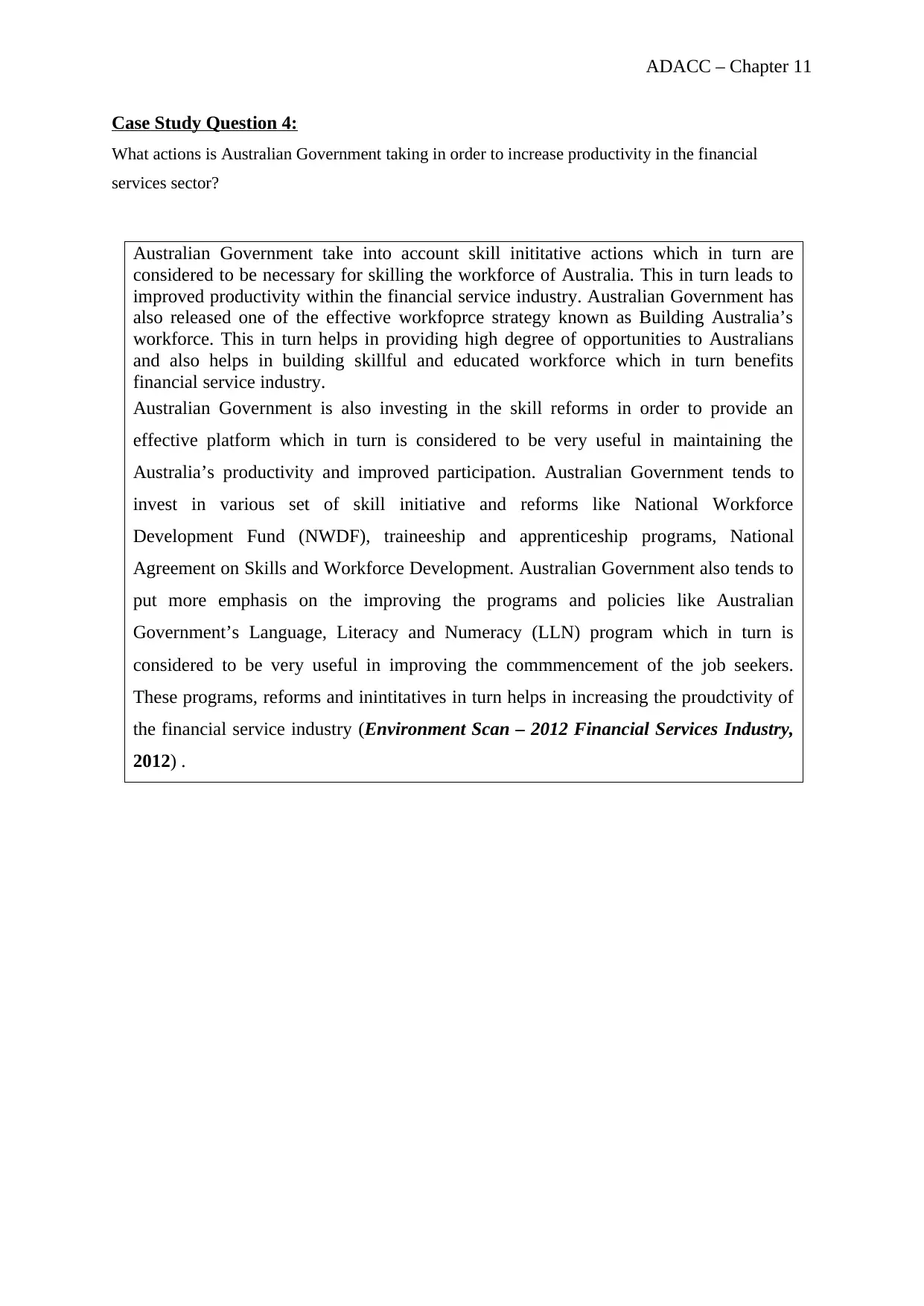
ADACC – Chapter 11
Case Study Question 4:
What actions is Australian Government taking in order to increase productivity in the financial
services sector?
Australian Government take into account skill inititative actions which in turn are
considered to be necessary for skilling the workforce of Australia. This in turn leads to
improved productivity within the financial service industry. Australian Government has
also released one of the effective workfoprce strategy known as Building Australia’s
workforce. This in turn helps in providing high degree of opportunities to Australians
and also helps in building skillful and educated workforce which in turn benefits
financial service industry.
Australian Government is also investing in the skill reforms in order to provide an
effective platform which in turn is considered to be very useful in maintaining the
Australia’s productivity and improved participation. Australian Government tends to
invest in various set of skill initiative and reforms like National Workforce
Development Fund (NWDF), traineeship and apprenticeship programs, National
Agreement on Skills and Workforce Development. Australian Government also tends to
put more emphasis on the improving the programs and policies like Australian
Government’s Language, Literacy and Numeracy (LLN) program which in turn is
considered to be very useful in improving the commmencement of the job seekers.
These programs, reforms and inintitatives in turn helps in increasing the proudctivity of
the financial service industry (Environment Scan – 2012 Financial Services Industry,
2012) .
Case Study Question 4:
What actions is Australian Government taking in order to increase productivity in the financial
services sector?
Australian Government take into account skill inititative actions which in turn are
considered to be necessary for skilling the workforce of Australia. This in turn leads to
improved productivity within the financial service industry. Australian Government has
also released one of the effective workfoprce strategy known as Building Australia’s
workforce. This in turn helps in providing high degree of opportunities to Australians
and also helps in building skillful and educated workforce which in turn benefits
financial service industry.
Australian Government is also investing in the skill reforms in order to provide an
effective platform which in turn is considered to be very useful in maintaining the
Australia’s productivity and improved participation. Australian Government tends to
invest in various set of skill initiative and reforms like National Workforce
Development Fund (NWDF), traineeship and apprenticeship programs, National
Agreement on Skills and Workforce Development. Australian Government also tends to
put more emphasis on the improving the programs and policies like Australian
Government’s Language, Literacy and Numeracy (LLN) program which in turn is
considered to be very useful in improving the commmencement of the job seekers.
These programs, reforms and inintitatives in turn helps in increasing the proudctivity of
the financial service industry (Environment Scan – 2012 Financial Services Industry,
2012) .
Secure Best Marks with AI Grader
Need help grading? Try our AI Grader for instant feedback on your assignments.
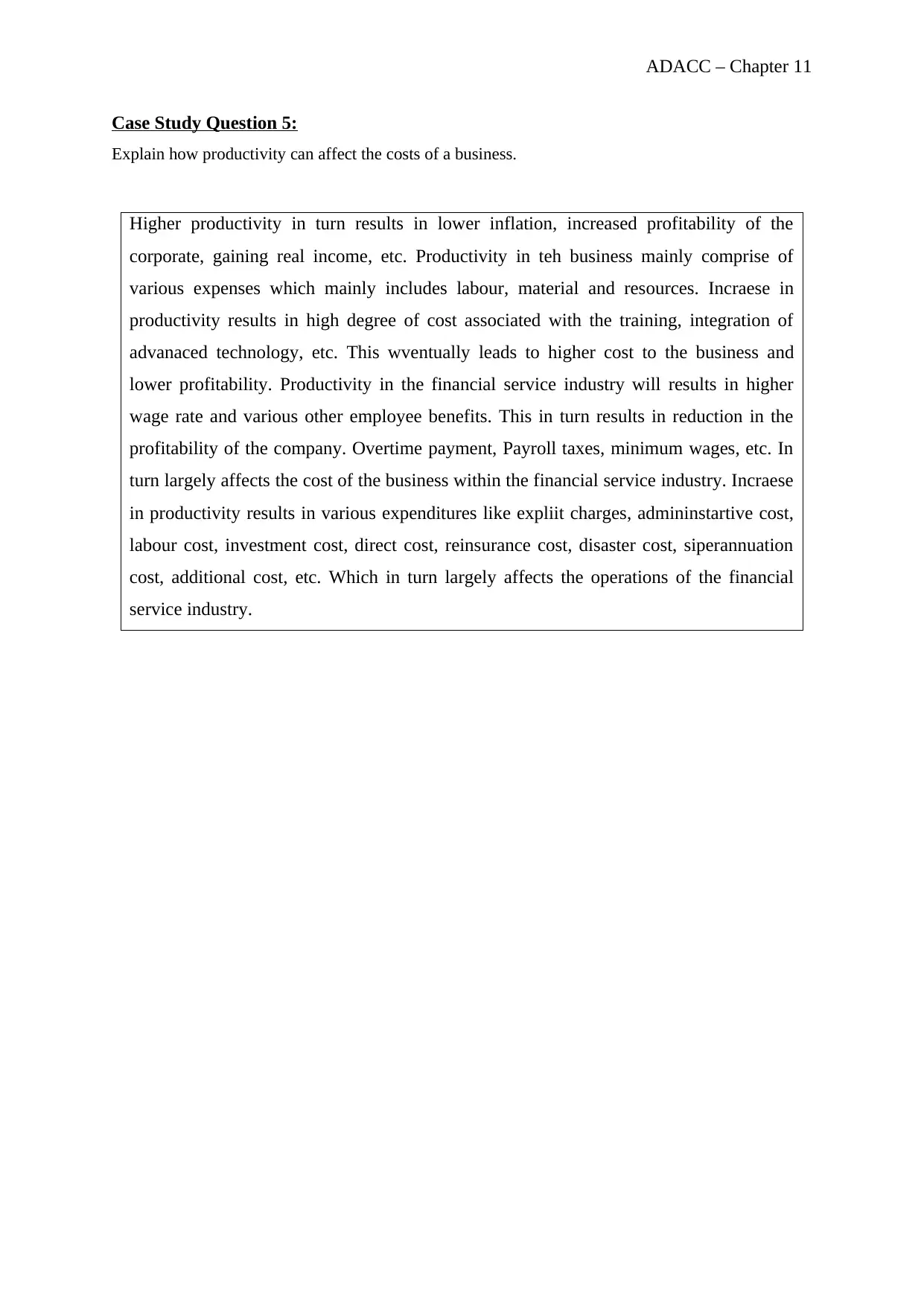
ADACC – Chapter 11
Case Study Question 5:
Explain how productivity can affect the costs of a business.
Higher productivity in turn results in lower inflation, increased profitability of the
corporate, gaining real income, etc. Productivity in teh business mainly comprise of
various expenses which mainly includes labour, material and resources. Incraese in
productivity results in high degree of cost associated with the training, integration of
advanaced technology, etc. This wventually leads to higher cost to the business and
lower profitability. Productivity in the financial service industry will results in higher
wage rate and various other employee benefits. This in turn results in reduction in the
profitability of the company. Overtime payment, Payroll taxes, minimum wages, etc. In
turn largely affects the cost of the business within the financial service industry. Incraese
in productivity results in various expenditures like expliit charges, admininstartive cost,
labour cost, investment cost, direct cost, reinsurance cost, disaster cost, siperannuation
cost, additional cost, etc. Which in turn largely affects the operations of the financial
service industry.
Case Study Question 5:
Explain how productivity can affect the costs of a business.
Higher productivity in turn results in lower inflation, increased profitability of the
corporate, gaining real income, etc. Productivity in teh business mainly comprise of
various expenses which mainly includes labour, material and resources. Incraese in
productivity results in high degree of cost associated with the training, integration of
advanaced technology, etc. This wventually leads to higher cost to the business and
lower profitability. Productivity in the financial service industry will results in higher
wage rate and various other employee benefits. This in turn results in reduction in the
profitability of the company. Overtime payment, Payroll taxes, minimum wages, etc. In
turn largely affects the cost of the business within the financial service industry. Incraese
in productivity results in various expenditures like expliit charges, admininstartive cost,
labour cost, investment cost, direct cost, reinsurance cost, disaster cost, siperannuation
cost, additional cost, etc. Which in turn largely affects the operations of the financial
service industry.
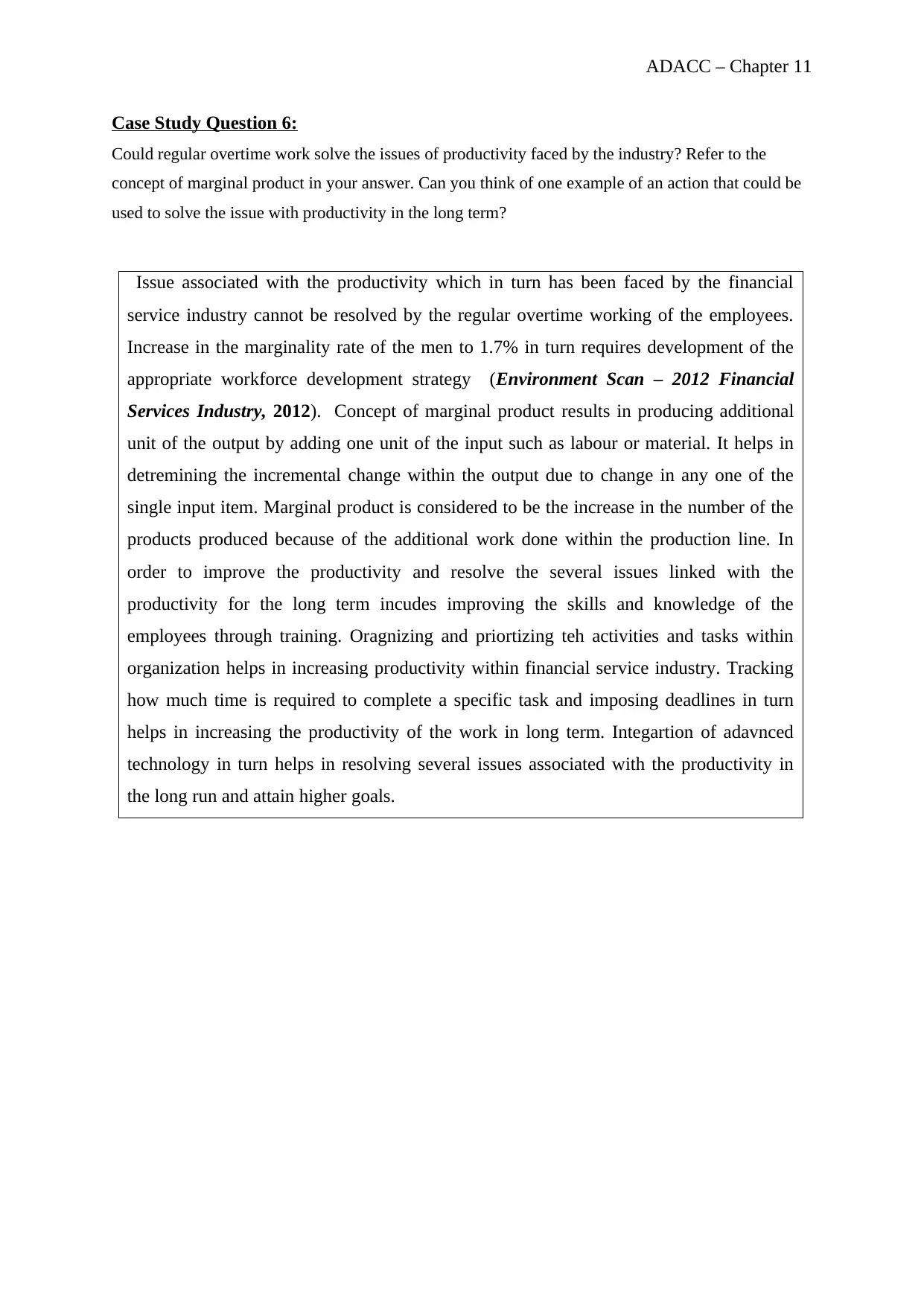
ADACC – Chapter 11
Case Study Question 6:
Could regular overtime work solve the issues of productivity faced by the industry? Refer to the
concept of marginal product in your answer. Can you think of one example of an action that could be
used to solve the issue with productivity in the long term?
Issue associated with the productivity which in turn has been faced by the financial
service industry cannot be resolved by the regular overtime working of the employees.
Increase in the marginality rate of the men to 1.7% in turn requires development of the
appropriate workforce development strategy (Environment Scan – 2012 Financial
Services Industry, 2012). Concept of marginal product results in producing additional
unit of the output by adding one unit of the input such as labour or material. It helps in
detremining the incremental change within the output due to change in any one of the
single input item. Marginal product is considered to be the increase in the number of the
products produced because of the additional work done within the production line. In
order to improve the productivity and resolve the several issues linked with the
productivity for the long term incudes improving the skills and knowledge of the
employees through training. Oragnizing and priortizing teh activities and tasks within
organization helps in increasing productivity within financial service industry. Tracking
how much time is required to complete a specific task and imposing deadlines in turn
helps in increasing the productivity of the work in long term. Integartion of adavnced
technology in turn helps in resolving several issues associated with the productivity in
the long run and attain higher goals.
Case Study Question 6:
Could regular overtime work solve the issues of productivity faced by the industry? Refer to the
concept of marginal product in your answer. Can you think of one example of an action that could be
used to solve the issue with productivity in the long term?
Issue associated with the productivity which in turn has been faced by the financial
service industry cannot be resolved by the regular overtime working of the employees.
Increase in the marginality rate of the men to 1.7% in turn requires development of the
appropriate workforce development strategy (Environment Scan – 2012 Financial
Services Industry, 2012). Concept of marginal product results in producing additional
unit of the output by adding one unit of the input such as labour or material. It helps in
detremining the incremental change within the output due to change in any one of the
single input item. Marginal product is considered to be the increase in the number of the
products produced because of the additional work done within the production line. In
order to improve the productivity and resolve the several issues linked with the
productivity for the long term incudes improving the skills and knowledge of the
employees through training. Oragnizing and priortizing teh activities and tasks within
organization helps in increasing productivity within financial service industry. Tracking
how much time is required to complete a specific task and imposing deadlines in turn
helps in increasing the productivity of the work in long term. Integartion of adavnced
technology in turn helps in resolving several issues associated with the productivity in
the long run and attain higher goals.
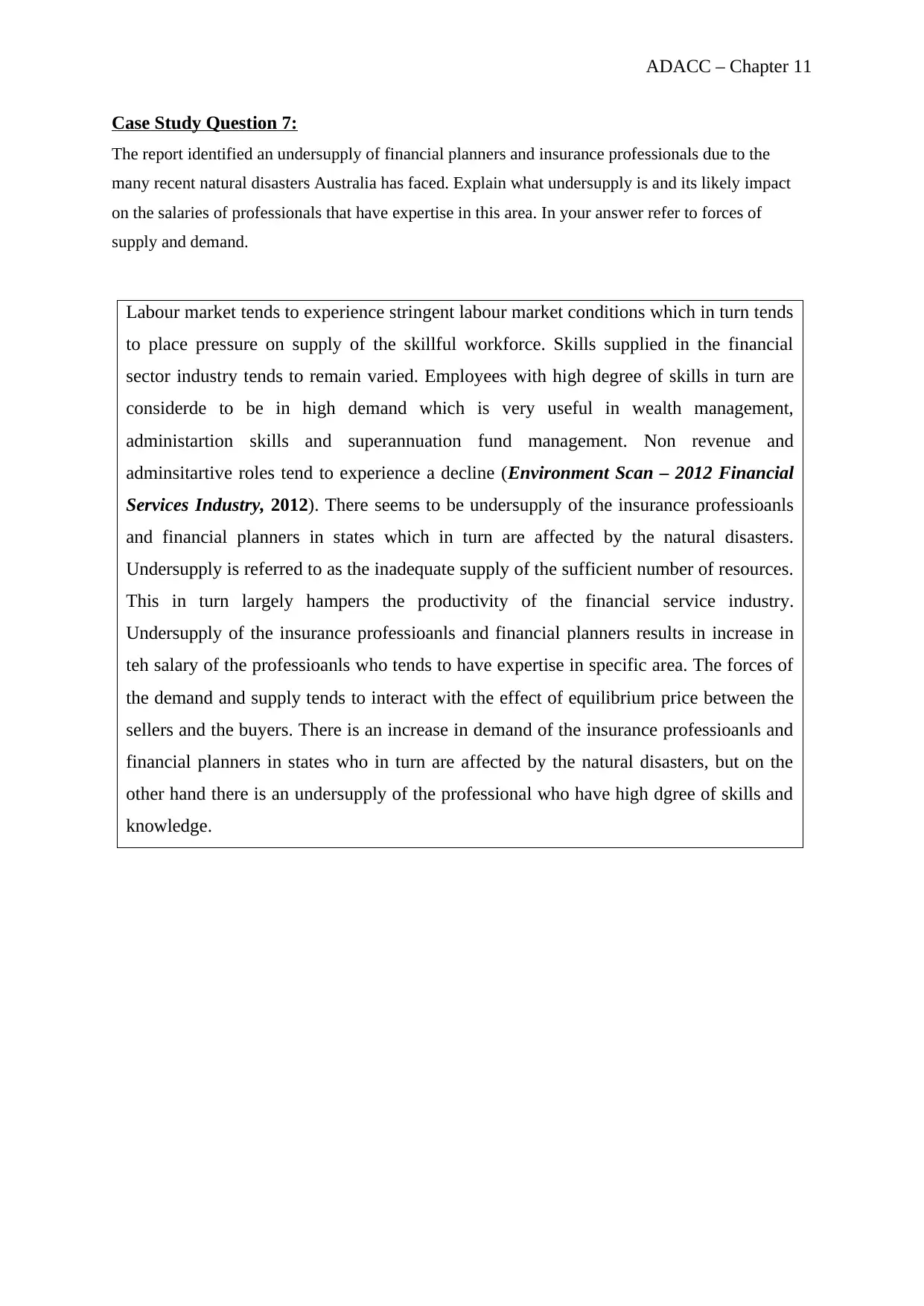
ADACC – Chapter 11
Case Study Question 7:
The report identified an undersupply of financial planners and insurance professionals due to the
many recent natural disasters Australia has faced. Explain what undersupply is and its likely impact
on the salaries of professionals that have expertise in this area. In your answer refer to forces of
supply and demand.
Labour market tends to experience stringent labour market conditions which in turn tends
to place pressure on supply of the skillful workforce. Skills supplied in the financial
sector industry tends to remain varied. Employees with high degree of skills in turn are
considerde to be in high demand which is very useful in wealth management,
administartion skills and superannuation fund management. Non revenue and
adminsitartive roles tend to experience a decline (Environment Scan – 2012 Financial
Services Industry, 2012). There seems to be undersupply of the insurance professioanls
and financial planners in states which in turn are affected by the natural disasters.
Undersupply is referred to as the inadequate supply of the sufficient number of resources.
This in turn largely hampers the productivity of the financial service industry.
Undersupply of the insurance professioanls and financial planners results in increase in
teh salary of the professioanls who tends to have expertise in specific area. The forces of
the demand and supply tends to interact with the effect of equilibrium price between the
sellers and the buyers. There is an increase in demand of the insurance professioanls and
financial planners in states who in turn are affected by the natural disasters, but on the
other hand there is an undersupply of the professional who have high dgree of skills and
knowledge.
Case Study Question 7:
The report identified an undersupply of financial planners and insurance professionals due to the
many recent natural disasters Australia has faced. Explain what undersupply is and its likely impact
on the salaries of professionals that have expertise in this area. In your answer refer to forces of
supply and demand.
Labour market tends to experience stringent labour market conditions which in turn tends
to place pressure on supply of the skillful workforce. Skills supplied in the financial
sector industry tends to remain varied. Employees with high degree of skills in turn are
considerde to be in high demand which is very useful in wealth management,
administartion skills and superannuation fund management. Non revenue and
adminsitartive roles tend to experience a decline (Environment Scan – 2012 Financial
Services Industry, 2012). There seems to be undersupply of the insurance professioanls
and financial planners in states which in turn are affected by the natural disasters.
Undersupply is referred to as the inadequate supply of the sufficient number of resources.
This in turn largely hampers the productivity of the financial service industry.
Undersupply of the insurance professioanls and financial planners results in increase in
teh salary of the professioanls who tends to have expertise in specific area. The forces of
the demand and supply tends to interact with the effect of equilibrium price between the
sellers and the buyers. There is an increase in demand of the insurance professioanls and
financial planners in states who in turn are affected by the natural disasters, but on the
other hand there is an undersupply of the professional who have high dgree of skills and
knowledge.
Paraphrase This Document
Need a fresh take? Get an instant paraphrase of this document with our AI Paraphraser
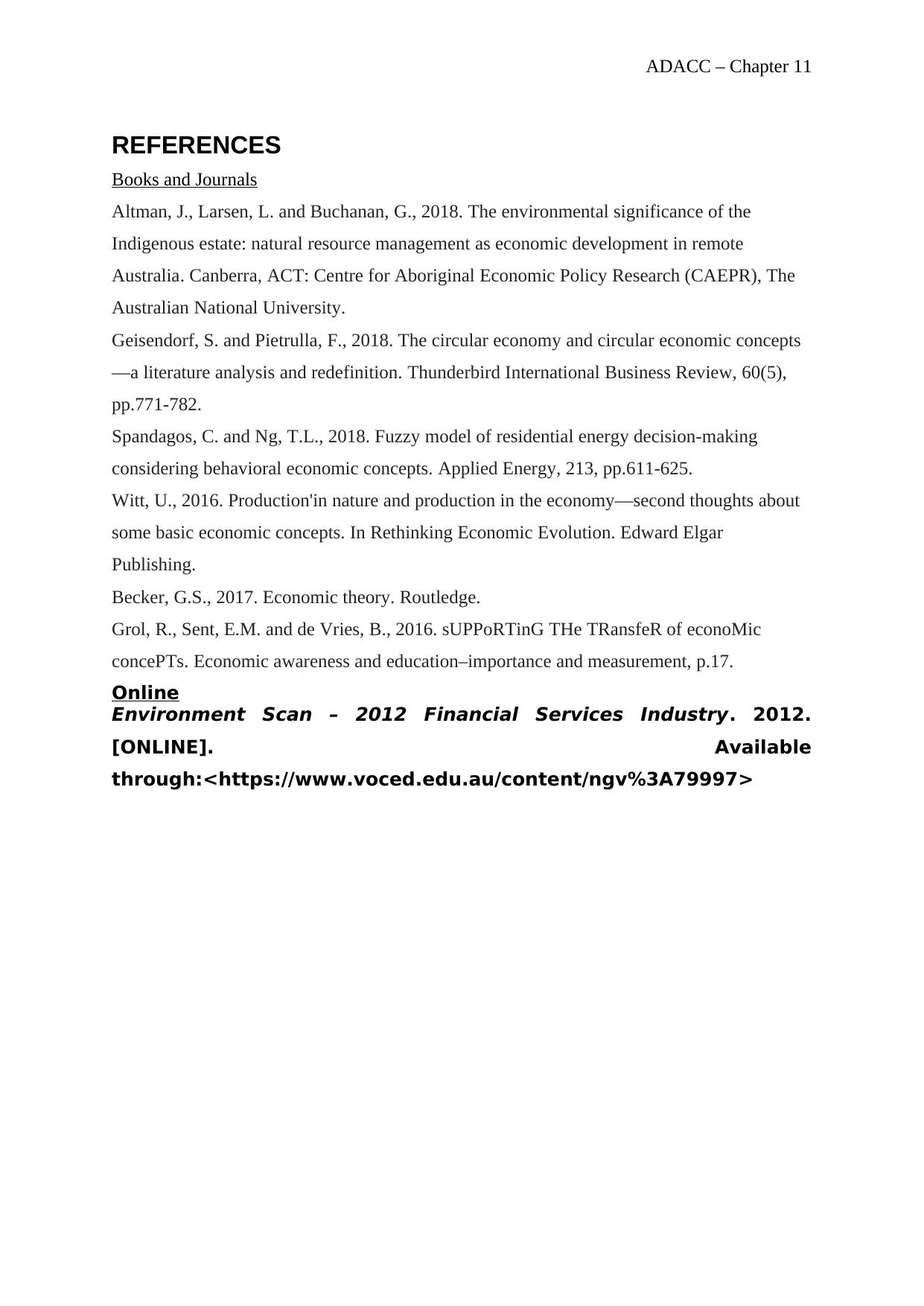
ADACC – Chapter 11
REFERENCES
Books and Journals
Altman, J., Larsen, L. and Buchanan, G., 2018. The environmental significance of the
Indigenous estate: natural resource management as economic development in remote
Australia. Canberra, ACT: Centre for Aboriginal Economic Policy Research (CAEPR), The
Australian National University.
Geisendorf, S. and Pietrulla, F., 2018. The circular economy and circular economic concepts
—a literature analysis and redefinition. Thunderbird International Business Review, 60(5),
pp.771-782.
Spandagos, C. and Ng, T.L., 2018. Fuzzy model of residential energy decision-making
considering behavioral economic concepts. Applied Energy, 213, pp.611-625.
Witt, U., 2016. Production'in nature and production in the economy—second thoughts about
some basic economic concepts. In Rethinking Economic Evolution. Edward Elgar
Publishing.
Becker, G.S., 2017. Economic theory. Routledge.
Grol, R., Sent, E.M. and de Vries, B., 2016. sUPPoRTinG THe TRansfeR of econoMic
concePTs. Economic awareness and education–importance and measurement, p.17.
Online
Environment Scan – 2012 Financial Services Industry. 2012.
[ONLINE]. Available
through:<https://www.voced.edu.au/content/ngv%3A79997>
REFERENCES
Books and Journals
Altman, J., Larsen, L. and Buchanan, G., 2018. The environmental significance of the
Indigenous estate: natural resource management as economic development in remote
Australia. Canberra, ACT: Centre for Aboriginal Economic Policy Research (CAEPR), The
Australian National University.
Geisendorf, S. and Pietrulla, F., 2018. The circular economy and circular economic concepts
—a literature analysis and redefinition. Thunderbird International Business Review, 60(5),
pp.771-782.
Spandagos, C. and Ng, T.L., 2018. Fuzzy model of residential energy decision-making
considering behavioral economic concepts. Applied Energy, 213, pp.611-625.
Witt, U., 2016. Production'in nature and production in the economy—second thoughts about
some basic economic concepts. In Rethinking Economic Evolution. Edward Elgar
Publishing.
Becker, G.S., 2017. Economic theory. Routledge.
Grol, R., Sent, E.M. and de Vries, B., 2016. sUPPoRTinG THe TRansfeR of econoMic
concePTs. Economic awareness and education–importance and measurement, p.17.
Online
Environment Scan – 2012 Financial Services Industry. 2012.
[ONLINE]. Available
through:<https://www.voced.edu.au/content/ngv%3A79997>
1 out of 26
Related Documents
Your All-in-One AI-Powered Toolkit for Academic Success.
+13062052269
info@desklib.com
Available 24*7 on WhatsApp / Email
![[object Object]](/_next/static/media/star-bottom.7253800d.svg)
Unlock your academic potential
© 2024 | Zucol Services PVT LTD | All rights reserved.





